Archive for the ‘Organization’ Category
Posted by denisefisher on November 21, 2010

All money matters are not of equal value, and while it would be nice to go through an orderly plan of reorganization in a standardized step-by-step plan, there are issues in your finances that need your urgent attention and can’t wait until they come up in the rotation. I have tried to speculate on the categories of imminent financial matters that should be at the top of the list for handling, and added specific issues that may apply to you. There may also be other issues that need your urgent action that are not listed below, but this listing should help prompt you and identify the financial matters that are screaming for your attention.
Print out this list, put stars next to any issues that apply to you, write your specific circumstances in the margins, or recreate your own personalized list to identify the financial tasks that need your immediate attention. I have arranged the categories below in what could be the general order of importance, but you know your circumstances best and can identify what issues bother you most. In any case, having that list is the start of creating an action plan, feeling a sense of accomplishment as you achieve your critical tasks, and experiencing peace of mind in knowing that your critical issues have been identified and being able to see what remains to be done.
Take care of these critical issues before getting back to your other financial planning matters.
1. Collect money that is due to you
- Tax returns
- Child support
- Reimbursement by employer for expenses, tuition, travel, purchases, etc.
- Returning recent unwanted purchases or damaged goods
- Filing rebates
- Filing insurance claims, warranty or service claims due to you
- Collecting on personal loans to friends/family members
- Claiming or cashing in on gift cards, uncashed checks, store credits (or giving them away)
- Getting credits for billing errors, unfulfilled or unacceptable goods or services
- Billing for services performed but not invoiced/charged/requested
2. Make sure you have cash flow coming in
- Get a job (if you don’t have one)
- Find additional work if needed
- Sell things that you don’t need to bring in cash
- Start any processes that are needed for getting financial support
3. Keep debt issues from causing further damage
- Stop spending on any non-essential purchases or services (you know this already, but you may need reminding, and you definitely need a conscientious plan to address this if it’s an issue)
- Avoid the use of credit cards, loans, and other financial fixes that only make matters worse
- Contact those to whom you owe money and can’t pay on the original terms (whether it be a utility company, bank, credit card company, friend or family member); it’s better to address the situation and try to work out a solution than to ignore it and cause further damage to your credibility
- Refinance mortgages, renegotiate credit card terms and loan repayments where you can and where it makes sense (consider any additional fees or other terms that may not be beneficial)
- Do not raid your retirement funds or home’s equity without serious consideration of the penalties and financial losses, and even then, this option should only be done in a desperate situation (not to pay credit card bills) – this may require some serious research or outside consultation from a trusted source
4. Pay money you owe
- Money that is past due, coming due, or needs to be addressed
- Taxes due
- Housing, Utilities, Auto, Insurance, Child Support
- Medical expenses
- Personal loans, maintenance fees, service charges, late fees, penalties, any payment issue that accrues additional fees from your inaction
- Payment owed for goods or services delivered
- Anything that involves a warrant, potential court case, collection agency, seizing assets, personal embarrassment
- Traffic Tickets, licenses, registrations, other auto-related issues
- Any other payment issues that bother you because you haven’t taken action or followed through (replacement of something you borrowed and then damaged or lost; payment of an item for which you were not charged, etc.)
- If you are told that you owe money, but you dispute it, this may be the instance for you to put your dispute in writing and send it to where it needs to go – the idea is to resolve any debt issues that continue to hang on and cause you stress
5. Take care of critical repairs
- Maintenance or repairs of plumbing, heating, cooling, doors & hardware, appliances, roofing system, electrical service, building structure, etc. that affect your security, safety, health, or prevents further damage from occurring (whether you own your home or rent)
- Maintenance or repairs to your vehicle that can make matters worse if not attended to, especially if they can put your vehicle out of commission, affect your safety, or cause further damage
- Maintenance or repairs that (though they may not be critical) seriously affect your quality of life, especially if it’s to the point that you are depressed or not fully functional, due to your living circumstances
- Health maintenance, screenings, testing, prescriptions, etc., especially as they apply to your health history, preventive measures with good return (e.g., dental care), and procedures/actions that have long-range impact and affect your day-to-day living capabilities
6. Eliminate recurring expenses
- Monthly, seasonal, or annual services you don’t use, don’t need, or could do without
- Warranty/service coverage on electronics, appliances, utility services that are not beneficial
- Low deductibles on insurance coverage
- Features on your phone, cable that are wasteful expenses or excessive for your financial situation
- Storage/rental costs – portable or self-storage units, garages, marinas, boat slips, and other places where you pay to keep vehicles, sports or recreational vehicles/equipment, furniture, personal items, collections, memorabilia, unfinished projects, items needing repair, and things you don’t know what to do with
- Memberships that are not fully utilized or participated in
- Magazines/publications that you do not read regularly
- Expenses that you pay that should be paid by someone else (this can apply to parents who continue to pay expenses of their adult children, even when they are fully employed [or capable of financial responsibility]; or people who pay recurring expenses of other friends or relatives and find it to awkward to tell the beneficiary of their support that they want to discontinue their financial subsidies)
7. Eliminate bad habits that cause you to spend money
- Gambling
- Smoking, alcohol, recreational drugs, partying
- Recreational shopping for clothing, hobby items, sports equipment, décor, tools, etc.
- Bargain shopping for food, household items, clearance items or purchases that are a good deal, items with perceived collectible value, items for projects you intend to take up or complete, home improvement purchases that go unused, items bought to stock up supplies (but which are eventually thrown out or not used)
- Spontaneous purchasing (especially under pressure or in social settings)
- Social spending on restaurants, entertainment, sports, events & activities
- Replacement purchases made to avoid dealing with lower cost repairs
- New trend purchases
- Convenience purchases, resulting from lack of planning (everything from ATM charges and bottled beverages to airport neck pillows and full-price tickets)
8. Prepare for upcoming financial deadlines
- Avoid fees, penalties
- Don’t miss financial opportunities (credits, rebates, returns, incentives, reimbursements, expense reports, income from sales, job opportunities, investment or purchase opportunities, grants, scholarships, tax deductions, credits, interest income, cash-ins, sales, bundling, advance payment discounts, advantageous actions that must be taken before tax year or tax filing deadlines)
- Maintain credibility (and your credit ratings)
- Protect your assets
- Reduce stress caused by not having your finances in order (owing payments, having utilities shut off, accounts closed, garnishment of wages, collection agents, IRS dealings, liens, court filings, eviction, conflicts with friends/family members between whom money is owed, general financial anxiety)
9. Determine which financial (or financially related) issues are not worth acting on & officially let them go
- Non-collection of personal loans you’ve made to others or financed on their behalf
- Unfiled expense reports, claims, lawsuits, or paperwork to get money you are entitled to
- Unreturned items with missing receipts, past the warranty or return deadline
- Purchased goods or services that are not being used and still taking up space or incurring expenses
- Holding out on the sale of a house, car, or other item you own that you think should sell for more money
- Lost opportunities of any kind
10. Change your mindset
- See yourself as a person who is financially responsible
- Become conscious of your spending, your income, your savings, and your financial decisions
- Realize that you need support from financial experts, and see yourself as a manager of your financial team (even if some of your team members are just authors, journalists, or economists)
- Start watching, reading, and listening to financial news, trends, and advisories as if they affect YOU
Next Steps
Here’s what to start thinking about for next steps:
- Identify your personal & specific issues that fall into these urgent financial categories
- Make a list that summarizes all your urgent issues
- Rank the urgent issues, using a rating system or prioritize them intuitively
Posted in Finances, Financial Management, Time Management | Tagged: accounts, bargain shopping, billing errors, billing for services, borrowed, cash flow, change your mindset, collect, collection agencies, conscious spending, convenience purchases, convenience spending, critical issues, critical repairs, deductibles, eating out, eliminate bad habits, entertainment, excessive, Expenses, fees, filing claims, filing rebates, finances in order, financial decisions, financial management, financial matters, financial planning, financial professionals, financial responsibility, financial support, find work, garnishment, get a job, gift cards, health maintenance, home equity, home improvement, home maintneance, home repairs, immenent, incurring expenses, late fees, loan repayments, lost opportunities, maintenance fees, money owed to you, money you owe, non-collection, owe money, past due, payment, payment owed, penalties, personal loans, phone features, preventive, protect assets, purchases, quality of life, Receipts, recreational shopping, recurring expenses, reduce stress, refinance, reimbursement, renegotiate, restaurants, retirement funds, return on investment, return unwanted purchases, sell things, service charges, social spending, spontaneous purchasing, stop spending, storage fees, store credit, taking up space, tax return, travel, tuition, uncashed checks, urgency, vehicle maintenance, warranty, wasteful expenses | Leave a Comment »
Posted by denisefisher on November 7, 2010
 Organizing the List
Organizing the List
Having written a list of everything financial I could imagine wanting to organize (in my previous post), getting my financial affairs in order still seems a bit overwhelming and without an identifiable course of actions. So I grouped my financial issues into categories, and was able to pinpoint the category with the highest priority for action.
Now all this planning and writing about how to get things in order may not seem like the most effective way to get things done, but I’ve found that thinking about what I have to do is part of the process. And separating the thinking from the doing allows for focus and keeps me from second guessing whether or not I’m working on the right task.
After some thought and some editing, and an attempt to list these categories in order of priority, I ended up with 13 categories. This is how my organized list turned out:
Imminent Issues & Recurring Events
- Timely financial follow-ups
- Bill paying procedure
- Eliminate recurring costs, avoiding penalties
- Not giving away time, services, or reimbursable expenses
- Leaving money on the table
- Maximizing income
- Additional sources of income
Getting in the Financial Mindset
- Read, watch, listen to sources of financial information
- Identify books, publications, online sources, radio, TV, podcasts to follow, courses to take, discussions to have, materials to use, experts you trust
- Establish routines, times, goals for keeping up on financial issues and news topics
- Create a plan of what to do, where and when to do it, and an estimate of how long it will take
- Adjust your plans and timeframes, as your financial organization progresses
- Allow time for research, decision-making, and breaks to catch up on your plan
Big Picture Assessment
- Net Worth
- Credit reports and FICO score
- List of all assets, debts, accounts, terms, beneficiaries
Back-up Plans & Getting Ahead of the Game
- Emergency savings
- Payback strategy
- Maintenance/repair/remodel/replacement plan
First Steps of Estate Planning
- Will
- Revocable living trust with incapacity clause
- Advance directive & durable power of attorney for health care
- Updated list of beneficiaries
Record Keeping & Filing (including setting up a filing system)
- Identifying all areas of finance and other important papers and things to file
Financial Review of Things Already in Place
- Retirement
- Savings
- Spending Patterns
- Loans & Credit
- Investing
- Real Estate
- Insurance
- Estate Planning
- Taxes
- Recurring auto payments and deductions
Identify what needs to be changed, added, and eliminated
- Note the obvious and the things you don’t know
- Research or consult to help make your decisions
- Define how to make these changes and what steps need to be taken
Goals & Policies
- Gift Giving
- Housing/Real Estate
- Savings for College/Education/Training (self or others)
- Retirement Plans
- Travel
- Next Career or Business Plan
- Purchase Plans & Wish List
- Borrowing/Debt Policy
- Net Worth Goals
- Integration of Other Life Goals with Financial Goals
Automating Finances
- Savings
- Payments
- Retirement Funds
- Tracking Expenses & Financial Status
- Paperwork Management & Tax Records
- Inventories of possessions
- Financial Review Plan
Finding & Using Financial Professionals
- Tax planning
- Purchase plan
- Inventory documenting all possessions
- Tax planning, record keeping & filing
- Paperwork management
Revisiting the Topic of Additional Sources/Streams of Income
- Insurance assessment (including Long Term Health Care)
- Financial goals (and integration with other life goals)
- Electronic financial record keeping
- Borrowing/Debt policy
- Financial review plan
Integrating Other Aspects of Your Life Plans (Get Fit, Get Organized, and Get Financial Affairs in Order)
- Purging, liquidating, consolidating, and reorganizing your stuff
- Planning meals, food purchases, and food inventories that support your budget & health
- Making choices about your lifestyle and activities that support your financial goals
- Teaching your children or other family members responsible financial management
Next Steps – What, Where, and When
My next step will be to identify specific concerns that fall into the first category – Imminent Issues and Recurring Events. I want to rank them into a prioritized list so that I can tackle them completely, one at a time. Working “at” a task isn’t usually the difficult part – it’s FINISHING that’s the toughest. But finishing is what needs to be done to get results. The “where” and “when” of my next step will follow my previous weekly routine. Weekly progress may seem like a slow pace, but it IS progress, and it’s realistic for me. So that’s what I’m going with for now.
- What: Identify my imminent financial issues, and recurring expenses, and put them in writing
- When: Sunday, 11 am – 2 pm
- Where: My designated work table (this is a clear space away from my usual desk, where I know I will get things done – you should try to find such a place for yourself, if you don’t already have one)
- Pre-planning task: Scan through financial files and paperwork no later than Saturday evening for reminders of pressing matters, making notes as needed
Posted in Finances, Organization | Tagged: accounts, activities, advance directive, assessment, automating finances, beneficiary, bill paying, borrowing, Budget, Categories, choices, college, consolidating, credit, debt, debts, durable power of attorney, education, emergency savings, estate planning, expense categories, FICO score, filing, financial goals, financial management, financial planning, financial professionals, financial status, finishing, gift-giving, Goals, housing, imminent, important papers, income, insurance, inventory, investing, life goals, lifestyle, liquidating, list, loans, management, market, net worth, next step, Order, organizing, paperwork, penalties, personal finance, plan, policy, posessions, pre-planning, purchase plan, purging, real estate, record keeping, recurring costs, reorganizing, responsible, retirement, review, revocable living trust, saving, taxes, teaching, tracking expenses, training, travel, urgency, will | 1 Comment »
Posted by denisefisher on October 21, 2010
 There is one main reason why people do not have their financial affairs in order: it’s easier NOT to do it. It’s a task that can be overwhelming because there’s no instruction book, no deadlines, and no starting point. And everyone’s situation is different.
There is one main reason why people do not have their financial affairs in order: it’s easier NOT to do it. It’s a task that can be overwhelming because there’s no instruction book, no deadlines, and no starting point. And everyone’s situation is different.
So, right here, right now, I’m going to create a starting point, put together a customized instruction book and action plan, and establish deadlines and timeframes.
The Starting Point – Choose a Model and Built on It
I am using the Suze Orman’s Action Plan as a starting template for my project of getting my financial affairs in order. Another resource that I like is Dr. Lois Frankel’s book Nice Girls Don’t Get Rich. By using these books as guides, I can write out a list of financial categories, add more specific tasks, and put together topics that will be used in my plan of action. So my starting point is to identify what is in the plan that will make me feel that my financial affairs are in order.
Put Together a Customized First Draft List
I started by just listing everything financial that came to mind (either from reference sources, or my own experiences), focusing on things I knew I needed to include for organizing my financial affairs. Consulting the suggestions of experts will help you identify the financial issues you haven’t thought of or don’t know enough about. I used the Table of Contents from the above mentioned books as my first source for identifying financial issues to put on my list. I could skip some of the topics that didn’t apply to me, and I could add other items that came to mind as I read through the contents. I know there are lots of other resources out there with helpful guidelines, but it would be easy to get bogged down in the research behind putting together the BEST plan ever. And I don’t want to do that. This is not a one-time project, and I will revisit this plan later, as situations change, and I have the need to add financial tasks to my list. For now, I will keep things simple, and start with the basics. Here are some of the categories and various items I came up with to start:
- Credit
- Retirement
- Saving
- Spending
- Investing
- Real Estate
- Additional sources of income
- Insurance
- Net Worth
- List of all assets, debts, accounts, terms, beneficiaries
- Credit reports and FICO score
- Bill paying procedure
- Estate Planning
- Will
- Revocable living trust with incapacity clause
- Advance directive & durable power of attorney for health care
- Updated list of beneficiaries
- Tax planning
- Emergency savings
- Payback strategy
- Purchase plan
- Maintenance/repair/remodel/replacement plan
- Inventory documenting all possessions
- Insurance assessment (including Long Term Health Care)
- Financial goals (and integration with other life goals)
- Timely financial follow-ups
- Eliminate recurring costs, avoiding penalties
- Tax planning, record keeping & filing
- Paperwork management
- Electronic financial record keeping
- Maximizing income
- Not giving away time, services, or reimbursable expenses
- Leaving money on the table
- Borrowing/Debt policy
- Financial review plan
Next Steps – What, Where, and When
At this point in the process, I started to run out of steam for what I needed to do next – which is to put the list into some kind of order. It took me about 3 hours to put a first draft list together and write it all down. But I also realized that there were next steps that I needed to identify before stopping for the day. I needed to identify what the next task was (organizing the list), including the “where and when” of doing that next task.
Creating a standard default “where and when” for this activity as a project that is repeated on a weekly basis is a good practice. Even when there are interferences that call for skipping a week or implementing an alternate plan, having a “Plan A” to return to provides the structure and continuity most likely to help me stick with this project for the long haul.
“Where”, was relatively easy for me to determine. I have two identified work spaces (depending on which location I’m in) where I know I do my best financial work. I don’t usually have to worry about interruptions from others, though when I have had this issue to deal with, my preferred “where” has been the local library reference room.
The “when” is trickier – things come up which can make it difficult to keep an appointment with myself (including my motivation and momentum, which is not to be overlooked). I first think of how long I will need (and how long I can stand) to work on and complete the next step. Usually two hours is the maximum tolerance level for staying focused on one task, non-stop. But I will allot three hours, because I will also need to write down what I’m doing, and I think it’s realistic for me. I’d like to connect this task with my weekly viewing of The Suze Orman Show, which is on Saturday nights at 9 pm (and which I follow with an hour of watching another financial show – Till Debt Do Us Part, which comes on immediately following Suze Orman). But I know I’m unlikely to be in the mood to work on my project at 11 pm on a Saturday night. So, I will plan to work on this task Sunday, from 11am – 2pm. In preparation for this timeframe, I will make it a point to do some pre-project planning on Wednesday at 7pm. There will be no defined length of time for this planning task – simply reviewing the information I have, and doing any additional work that I feel like doing will be the goal. To summarize, here are my next step details:
· Task: Organize the List
· When: Sunday, 11 am – 2 pm
· Where: My designated work table
· Pre-planning Review: Wednesday, 7 pm
Motivational Task: Watch The Suze Orman Show, Saturday, 9 pm; followed by Till Debt Do US Part at 10 pm.
Posted in Estate Planning, Finances, Mindful Spending, Organization | Tagged: accounts, Action Plan, advance directive, assessment, assets, beneficiary, bill paying, borrowing, credit, Credit Cards, debt, emergency savings, estate planning, Expenses, fees, FICO score, filing, financial goals, financial planning, income, insurance, investing, investments, list, Lois Frankel, Maintenance, Money, Motivation, net worth, Nice Girls Don't Get Rich, payback, penalties, personal finance, plan, Planning, policy, power of attorney, purchase plan, real estate, record keeping, recurring costs, repair, replacement, retirement, revocable living trust, saving, Spending, Suze Orman, tax planning, Till Debt Do Us Part, What to do, will | Leave a Comment »
Posted by denisefisher on August 8, 2009
 Last August, Seth Godin wrote a blog post about why you should take on a project to finish during the last two weeks of August. In the US, he claims, those are the slowest two weeks of the year (though I’d guess that the end of December would claim that distinction). He suggests that while everyone else is getting in their last days of vacation and basically coasting, you should focus on finishing a 2-week project and pursue it to completion like your hair is on fire.
Last August, Seth Godin wrote a blog post about why you should take on a project to finish during the last two weeks of August. In the US, he claims, those are the slowest two weeks of the year (though I’d guess that the end of December would claim that distinction). He suggests that while everyone else is getting in their last days of vacation and basically coasting, you should focus on finishing a 2-week project and pursue it to completion like your hair is on fire.
Coincidently, mid-August is six months before my next birthday. I have lots of things I’d like to accomplish before my next birthday. Perhaps too many. Having too many options and not much of a plan is a formula that pretty much assures that nothing will get done. Creating a plan and completing a significant task builds momentum.
September always has that back-to-school, time-to-get-serious-again feeling to it. I’m imagining how great it would feel to be ahead of the curve and have a plan of action that would allow me to hit the ground running the day after Labor Day. I can dig it.
Before I determine my August project, I’m going to write up a list of potential prospects from which to choose. Then I’m going to pick one and finish it. I’ll need to keep in mind that it has to be something that can be completed in two weeks, and not be unrealistically optimistic about what I can accomplish.
Do you want to play along? Here’s the goal for next week: Choose your own 2-week project for the end of August, make a plan, and focus on finishing it like your hair is on fire.
You’ve got a week to start deciding on a plan. Go.
Posted in Personal Style, Productivity, Time Management | Tagged: bucket list, deadline, decision making, energize, finish, follow through, Goals, intention, lifetime goals, list writing, look forward to, mindful, Momentum, Motivation, plan, preparedness, Procrastination, Productivity, project, Seth Godin, Time Management, time remaining, urgency, What to do | 1 Comment »
Posted by denisefisher on May 29, 2009

People of importance have schedules. They live their lives with purpose and have things to accomplish. They can’t afford to set aside their planned obligations to tend to the interruptive whims of others. They don’t wait to find out what’s going to happen before deciding what they should do; they have a vision of where they’re going and they plan ahead. Michael Phelps doesn’t swim laps only if he can find time to fit it into his daily agenda. Oprah Winfrey doesn’t go on the air without having scheduled her guests and program topics far in advance, or without having coordinated countless details in preparation for the show. Seth Godin doesn’t wait to write a blog post until he feels like it, nor does he casually think about writing a book without scheduling when he will work on it and establishing a deadline for completing it.
These people didn’t start scheduling their time once they became prominent figures. They reached their celebrity status largely because they’ve had the self-discipline to follow through on their directed planning. Sure, these people may have trainers, managers, producers, and support teams to help them with their itineraries and agendas now, but even with assistance, they still have the responsibility of making time to pursue their goals while managing day-to-day tasks and obligations. They learned to work with a schedule that would assure that they were doing the things they needed to be doing when they needed to be doing them.
How can you create a schedule that works for you?
You can create schedules for different timeframes (daily seems to be the most common), but I find it effective to start with a weekly schedule. By focusing on just one thing each day – one project or one type of task (using a specified theme of your own choosing) you can create a manageable and flexible weekly format. There will be tasks that you do daily at their appointed times, but if you don’t plan for other projects, the daily minutiae will consume your entire day, and subsequently, the entire week. And if you don’t schedule the time, you’ll never make any progress on those larger projects that need to have time designated for their attention.
Lets look at a low-tech way for creating a reusable weekly schedule that incorporates recurring tasks, and includes a designated day for working toward a long range project, one week at a time. By designing a template-like schedule, you don’t have to create an entirely new schedule every week. Similar tasks are grouped together to be done on a designated day of the week. When new tasks arise, they are incorporated into the weekly schedule on the day designated for those types of tasks. When your dry cleaning is ready to be picked up, you don’t have to adjust your existing schedule to accommodate that task, you simply add that task to the next day designated for errands.
If you have a good feel for how to structure your week, you can jump right in and label each day of the week with a preliminary theme. Alternatively, you can draft a concept schedule that describes your anticipated energy level or other factors that will affect how you plan your week. Shown here is a such a draft:
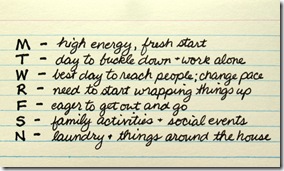
Make a list
If you want to make your schedule comprehensive, you need to identify recurring tasks as well as project-related tasks that you want to accomplish, and make sure that your themes cover those tasks. Start by listing the type of activities you engage in on a weekly basis – not necessarily the specific activities, but the type of activities you could describe as a category. Things like running errands, studying, home maintenance projects, writing, or socializing with family & friends. Add to that list projects or pursuits that you want to accomplish (write them all down, you can edit or prioritize or phase your goals as your schedule develops). Projects and pursuits might include reorganizing the garage, creating a business plan, writing a song, restoring a classic car, planning and saving for a two-week trip to Australia, reading 12 business books over the span of a year, or making a quilt. You can create a separate schedule for work and personal tasks, or you can combine your roles to focus on the system holistically – the latter is especially helpful for those who work from home or have unconventional work schedules.
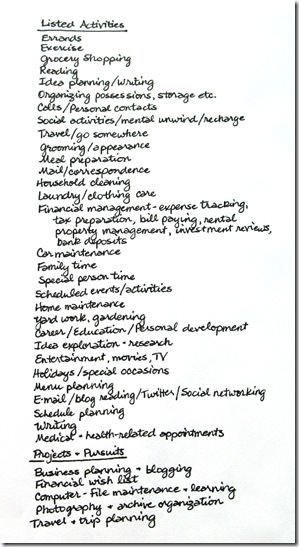
Group your weekly tasks
Categorize your list of tasks and activities by a descriptive label (such as “errands”, “correspondence”, etc.). Identify and mark similar tasks on your list by circling them, color coding, or using symbols in the margin. Think about where and when you will be doing these tasks as you create your categories. You will most likely end up with too many categories of lists on your first try. On your next revision you can look for categories that can be combined under a broader heading (for me, I eliminated the theme of “laundry/wardrobe” and reassigned the related tasks to my “catch-up day” or my “home projects day”). Some of your tasks will probably fit into more than one category – that means you either need to refine your theme description or identify the primary aspect of the task that helps you select the appropriate category.
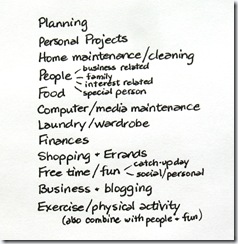
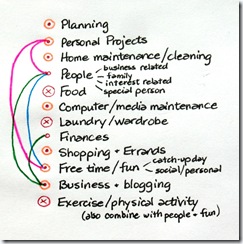
Create a daily theme
Whittle down, combine, and refine your categories until you come up with a list of 7 theme names – one for each day of the week. You will probably need to play with this step and do some editing until you find suitable descriptions for your themes – you can also go back later and revise them after you’ve created a prototype or given the plan a test drive. The important thing is to make it work for your own personal style.
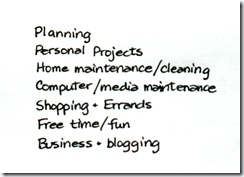
The importance of a name
The words you use when naming your daily themes can have a profound psychological and motivational effect on you, so choose your labels carefully. If the theme name “yard work day” makes you think of drudgery to be avoided, change the name to something more inspiring, like “landscape architecture day.” The naming process can be broken into a series of smaller steps. For me, it worked best to write up a bunch of descriptive words or phrases to articulate the “feel” of a particular day’s theme. I wrote something like “people/calls/correspondence/follow-up/obligations” to start with, and eventually ended up with the label of “business day,” since it’s a day for which I want to approach my tasks in a business-like manner. The cool thing about this technique is that a well-chosen name really helps to create an image and set the tone for that day’s activities. It’s almost like taking on a role, dressing the part, assuming the characteristics, and behaving in a manner consistent with that image. After creating a patchwork of descriptive words and phrases, it was easier to select the theme name that summarized my intended focus. You can also change these names later if you come up with a better title, so don’t get too perfectionistic about it.
Assign each theme to a day of the week
To make your recurring schedule work, it’s important to identify which day of the week is best suited for your particular themes of tasks and activities. If you have competing days, you’ll have to play around with your options to get the best fit. I like Sundays for planning, in anticipation of the upcoming week. I like Mondays for assigning myself the hard stuff, doing important tasks, and working through meticulous details – the tasks that I can do best when I’m fresh and ambitious.

I’ve recently realized (after 50 years of life experiences) that I need to include some kind of catch-up day in my schedule to accommodate the unexpected things that come up and interfere with my plans. This also allows me to complete tasks that take longer to finish than what I’d scheduled, and it provides some forgiveness for good intentions gone awry. If you don’t have some kind of catch-up day included, every little obstacle and diversion will put your remaining schedule behind and might make you want to write off the rest of the week as a loss, and wait to start anew on Monday. However, if you designate a weekly catch-up day and you don’t actually need the day to catch up on your tasks, you can use that time to work ahead or to do something just for you.
If you don’t know where to start – start with “Trash Day”
When a major construction project is planned and scheduled, it’s the industry standard to start with the demolition and excavation. You’ve got to clear the project area to provide room to start on the new construction or renovation. This standard also works well for planning a personal schedule. If you’re not sure which days should be assigned which themes, start with the day before your community’s scheduled trash pick-up. This will be your demolition and excavation phase. The trash pick-up will always come on that day, and will not fluctuate, even if something important comes up (except, perhaps, around certain holidays, in which case there is a planned shift in scheduled trash pick-up). So on the day before trash day, designate it for cleaning out your refrigerator, and from there, you will find that other tasks will naturally flow.
If you’re clearing out your refrigerator, it may also be a good day to schedule leftovers for dinner, a day to plan your grocery shopping list and upcoming menus; and while emptying the waste baskets in other rooms of the house, you might find another compatible task to include for that designated day. In mild weather, if you have a yard, the day before trash pick-up may also be the ideal day to bag up yard waste, assuming you don’t have yard work scheduled for some other day of the week. My “day before trash pick-up day” is Wednesday. Wednesday is also the day I chose to designate as my catch-up day. It’s a nice mid-week break that allows me to purge unwanted items, clear the decks, and regroup for a second phase of productivity for the week.
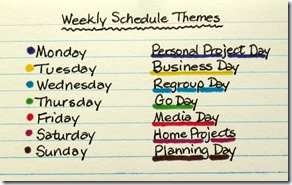
Put your plans & schedule in writing
This step is really important. If you’ve taken the time to think through the details of an effective schedule, it’s worth the extra effort to write out your final draft in a presentable form. This reinforces the notion that your schedule is of some importance, not just a whimsical exercise done for fun. Writing your schedule on card stock or on an index card makes it easy to locate for quick reference; an index card can double as a bookmark for your planner or a book. Post your schedule where you can see it or just establish it as your policy.
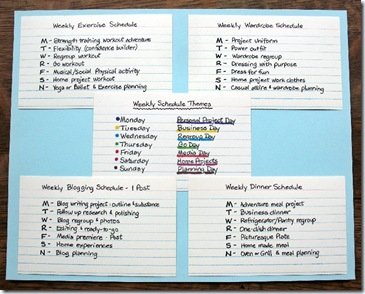
Expand the theme
Once you have a theme, you can use it to create schedules for other roles, projects, and pursuits in your life. I created a schedule for blogging, exercising, meal planning, wardrobe planning, and TV watching. Each of the subsequent schedules kept with the original scheduling theme to keep the activities compatible.
Act like a “schedule person”
For your schedule to be effective, you have to honor your commitments and expect that others will do the same – especially the activities that are scheduled for yourself. Don’t allow others to trivialize your planning by asking you to set aside your plans “just this once” to go do something fun or to help them meet their deadlines, with the rationalization that you can catch up on your things tomorrow.
Refer to your scheduling policy when coordinating tasks with others. Your daughter needs some new shoes for soccer or it’s mentioned that the car is due for an oil change? Say, “I’ll put that on the agenda for next Tuesday, when I do errands.” If you are working on a personal project which needs 2 hours of uninterrupted focus each week, go to the library or someplace where you won’t be disturbed. Tell your family and social contacts who might randomly call you that you’re not available on Thursdays – that’s your research & writing day.
Colorful visualization
I even created a themed schedule of colors for the week (this was actually an integration of a color-coded system I had previously created to help organize my “to do” lists). This may seem to take the concept of a theme to extremes, but hear me out. The colors I selected visually reinforce the emotional setting for that day’s activities and helps to create the image and enhance the story behind the theme. I also use descriptive words that remind me of my color choices and provide an association between the colors and the themes.
Now, here’s the cool part: Selecting colors allows you to color code tasks on your master list – just put an appropriately colored dot next to the associated task on your list. You’ll be able to add tasks to your list as they occur to you, in any order, then categorize them with colored dots than you can easily identify when you scan your list. Take the color coding even further by integrating color-matched folders, post-it notes, and page tabs. If you are a visual person, and you like themes, categorizing, and colors, this could be a motivating factor in getting you to create and use such a system. If not, skip the color-related mentions. As always, the best plan for you is the one that you’ll use.
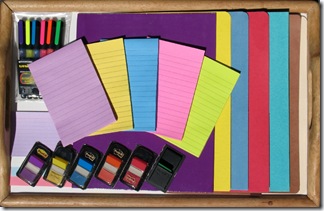
Weekly scheduling time
Once you’ve developed your weekly schedule template, you will have to take time (usually once a week) to decide which specific tasks will be scheduled for the upcoming week. You only have so much time each day, and your master to do list (color-coded or not) has more items on it than you can fit into your schedule. So you have to be selective and be careful not to overbook.
Productivity studies suggest that only 40-60% of your available work hours be designated for structured activities. The rest of your day will be consumed with daily tasks and unstructured activities. As you start to do the math, you’ll quickly realize why you never seem to have enough time for everything that you want to do. But don’t let that deter you. Focus on finishing the tasks you start. You won’t be able to complete everything, but at least you’ll have the satisfaction of finishing your selected tasks. That’s better than working on twice as many projects but completing none of them. The beauty of planning a weekly schedule is that your plan will be in place before your day begins, and you won’t need to feel overwhelmed by the number of things you have to do or waste your time deciding which task should have priority at any given moment. You’ll already have that plan.
The weekly schedule and reality
Focusing on one theme per day allows you to postpone to-do tasks to their designated days without getting distracted or worrying that things will fall through the cracks. Your weekly schedule is the Plan A. It has flexibility to it, but be careful about how frequently you resort to a Plan B. If the exception becomes more of the rule, you’ll lose the benefits of having a weekly schedule. However, if unavoidably urgent issues come up, or an unexpected opportunity arises, you can often swap days, and avoid pushing your entire schedule back a day. That’s when those scheduled catch-up days come in handy.
Expect that you will have to refine your themes and revise them from time to time, due to such things as changes in seasons, life situations, or personal preferences. But don’t think of your schedule as an assignment that is imposed on you. Instead, think of your schedule as your script – a directed plan that’s standard issue for people of importance, like you.
P.S. For time planning purposes, it took me about 3 hours to set up a weekly schedule template, following the steps I’ve described. I do things slowly and very thoroughly, so adjust your own time estimate accordingly. Once your schedule is initially set up, you can do your weekly planning without so much intensity and detail. Please comment with suggestions and scheduling tips that have worked for you. I’d like to include your successful techniques in a future edition on this topic.
Posted in Organization, Personal Style, Productivity, Routines, Time Management | Tagged: activity, catch-up day, decision making, designated, Dinner, efficiency, errands, Goals, grocery shopping, Healthy Eating, list writing, Maintenance, menu planning, Personal Style, physical activity, plan, Planning, post-it notes, preparedness, Productivity, reality check, Routine, Schedule, self-discipline, simplicity, structure, system, tasks, theme, Time Management, trash day, weekly plan, What to do, workout, write | 16 Comments »
Posted by denisefisher on May 14, 2009
 Here are some thought-provoking questions that may elicit a sense of uncertainty, if not panic:
Here are some thought-provoking questions that may elicit a sense of uncertainty, if not panic:
- Do you know how many online accounts you have?
- Do you have a list of them anywhere?
- Is that list written or printed out (not just on your computer)?
- What about passwords to your accounts?
- Have you informed anyone about your account info, and do they know where/how to find and access it?
- Where are your digital photos and important electronic documents kept?
- Where are your purchased music files and other purchased downloads stored?
- Are your media files and other documents accessible to someone you’d want to have them?
- What about your private files or accounts – are there any you’d want destroyed or closed without being viewed?
- Do you have any arrangements made for services or subscriptions that are automatically renewed and charged to your credit card or other financial accounts?
NPR’s program, All Things Considered, did a story on 11 May 2009 about this very topic. Click on this link to read about, or listen to, Your Digital Life After Death.
Over the past few years, several businesses have emerged with online sites and subscription services to deal with the related issues of legal matters, privacy concerns, electronic bequeaths, and designated access, as well as legacy wishes and remembrances.
Listed below is an extensive selection of online resources that might help you in planning the digital details of your eventual demise – they include all of the services I could identify as of the date of this blog posting. I have visited each of the sites to find out what they offer, how their system works, and the rates they are currently charging for their services. The summary descriptions are provided here:
AssetLock.net – This site provides a digital version of traditional estate planning. A template is provided to help remind you of what to include. You can store documents, instructions, and include a listing of accounts and passwords that will be accessible to designated individuals upon your death. You decide who can access which of your entries. There are 3 levels of services and pricing: 20-100-unlimited entries; 20MB-1GB-5GB storage; annual fee of $10-$30-$80.
VitalLock.com – This site describes itself as being in the “Alpha” stage of development and is not yet active.
LegacyLocker.com – A seemingly well-developed service and clearly, the most widely promoted system of its type, this site requires users to designate beneficiaries for their information as well as verifiers of their death. One of its defining criteria is the human oversight element, which requires that a human being provide the company with a death certificate before it will release information or access to the designated beneficiaries. There are 2 levels of services and 3 levels of pricing: the free account includes 3 assets, 1 beneficiary, and 1 legacy letter; the premium service includes unlimited assets, beneficiaries, and letters, and can be paid by a $30 annual subscription or a one-time fee of $300.
SlightlyMorbid.com – This site’s purpose is to send messages or notifications to your online friends in grave situations (not just the situation of your death). Plans are priced as one-time fees, which is described as being similar to the way you would pay for someone to prepare a will. It covers situations of death, natural disaster, accident, serious illness, or whatever you specify. You designate one trusted friend (or up to 5 or 10, for premium plans) and that friend will send out a message to 10 (or 30 or 50, for premium plans) of your online contacts to notify them of your condition, based upon messages you have written in advance. Your trusted friend cannot view or change the messages – they can only activate their delivery. Changes and updates are free for 3 years; after that, changes can be made with a small update fee. The one-time set-up fees are $10-$20-$50.
GreatGoodbye.com – This site’s tagline is “e-mail from the grave.” Its service allows a trusted person with activation codes to send out your final e-mail message with a photo attachment upon your death. When the trusted person activates the process of delivering of your message, a notification is sent to your e-mail address and you are given 21 days in which to cancel the ultimate delivery of your message(s). I suppose this is in case your trusted person makes a mistake, becomes no longer trustworthy, or you make a miraculous unexpected recovery. Premium packages can include audio or video attachments. There are 4 levels of services and each service has the option of an annual or one-time fee: 1-3-10-500 e-mails; yearly fees of $10-$20-$36-$50; one-time fees of $39-$87-$150-$219.
MyLastEmail.com – This site’s service is basically an online memorial page that you set up in advance, and is made accessible upon your death. The free service includes the posting of 1 document, 1 image, 1 video, and notification of 2 recipients. Premium packages are mentioned on the website, but apparently are not yet available.
YourPersonalScribe.com – This service is unique in its personalization of creating your life story. Sharon Scribe (yeah, that’s who provides this service) writes your personal obituary in advance, with your help. She uses a questionnaire followed by a personal interview with you, as well as interviews with close family members, friends, and colleagues, to prepare your life story. I don’t know what will happen when Sharon Scribe dies, but she also writes wedding toasts, poetry, and tributes for other special occasions in one’s life. The base rate for this service is $300, but has some flexibility for lower income clients.
Deathswitch.com – This site’s model has a very futuristic sci-fi feel to it (even the audio you hear when the page opens or when you roll over a link is very space-age sounding). They call it information insurance. I’d call it a life-watch service. It’s very different from others in that it does not require you to designate a trusted person with the responsibility for initiating the services upon your death. The website summarizes it nicely as “an automated system that prompts you for your password on a regular schedule [at intervals designated by you] to make sure you are still alive.” If you do not respond to multiple follow-up prompts, pre-scripted messages are automatically e-mailed to your named recipients. The company encourages you to test out the service by having the death messages sent to yourself. If for some reason you did not reply (but are still alive) you will get a preliminary message allowing you to click a link that says “Wait I’m still alive!” You can set up a free account that will send your message to 1 recipient with no attachments. The premium account sends up to 30 different messages to up to 10 recipients each (300 recipients total). I could not find the rate information for premium accounts on the site, but an Associated Press article about this service mentioned that it was $20/year.
I scanned through my hand-written list of online accounts (I have 7 pages worth) and found these representative accounts among my listings:
| e-mail accounts |
AOL, Yahoo, G-mail |
| social networks |
Facebook, Twitter, Linked In |
| financial accounts |
credit union, bank, mortgage company, Visa, home equity line of credit |
| investments/retirement |
Thrift Savings Plan, brokerage accounts, retirement account |
| travel-related sites |
frequent flier miles, Travelocity account |
| merchandise accounts |
Amazon, PayPal, ebay, iStockPhoto, iTunes |
| image/video/communications |
Flikr, YouTube, Skype, Oovoo |
| recurring/renewable payment accounts |
Verizon DSL service, AOL internet service provider, Corporate Housing ad, GoDaddy domains, Franklin County property tax |
My listing will probably remind you of some of your accounts that need to be considered in your planning arrangements. If you prepare and store documents or photos online (also referred to as “the cloud”) you need to take these files into account too. It’s not much of a virtual leap to go from the cloud down to earth and onto your computer and hard drives. You’ve got a lot of information on your computer to consider in your planning too.
These aren’t just issues to consider in anticipation of your death. With so much information being stored electronically, you’ve got a lot of digital eggs being kept in various compartments, but all in one basket.
Have you ever had your computer crash or had your computer lost, stolen, damaged, or destroyed? I have. And so have lots of others. Find someone and ask them about it – they’ll tell you what it was like. When my computer was stolen, the most devastating loss was my collection of family digital photos. The thief could’ve had the computer. I just wanted the files. I had some of the files printed or stored elsewhere, but most of them weren’t backed up, copied to others, or printed out as photos. They were gone forever.
Don’t be lulled into a false sense of security by thinking you’re covered because you back up your files onto an external drive or some other media. If someone breaks into your home and steals your computer, and the hard drive or other media is stored nearby, they’re going to take them all. Same thing for a natural disaster. A fire, flood, electrical- or wind-storm comes along and all your electronic equipment and storage media is likely to suffer the same fate. Ask the victims of Hurricane Katrina.
You’ve got options for saving your data and planning for access and/or deletion of your online accounts, but you have to put the plans in place now. You may not have the advance notice of your impending death in which to take care of these preparations. And even if you do, will you want to spend the remaining months of your life getting your accounts and online documents in order? Will you even have the energy or ability? Think about it, make a plan, and take some preliminary action to get things started. It’s better than doing nothing.
Here’s a closing thought: You can put together your own service plan – a simple, low-tech version of the packages mentioned above. But you actually have to do it. If paying someone else will get you to take action, it would be worth doing that. Even if you start out with a free online plan or put together a paid premium plan for one year, you’ll have organized your information and considered the details of your arrangements, and would be able to cancel your service after a year, by switching to your own at-home version. Enlist another family member to take on this task with you. They need to do it too, and may not have thought about it or started it either. Use the power of partnership and accountability to get your affairs in order.
(Editorial note: for any of you who may be wondering about my previously mentioned grand finale of wardrobe organization, I am in the process of completing and editing it. It’s very long and detailed, even more than my usual posts. So it may be published in a format other than a blog post. Updates will follow.)
Posted in Estate Planning, Finances, Legacy, Organization, Personal Style, Public Radio | Tagged: accounts, accumulation, arrangements, assessment, Asset Lock, assets, awareness, beneficiary, cloud, collections, computer, death, Deathswitch, decision making, disaster, documents, dying, e-mail, estate planning, executor, family, Finance, Great Goodbye, hard drive, Identity Theft, instructions, intention, internet, investments, Legacy, Legacy Locker, life story, lifetime goals, media, memorial, memory, Motivation, My Last Email, NPR, obituary, online, passwords, personal finance, photos, plan, Planning, posterity, preparedness, Procrastination, project, reality check, retirement, self-discipline, Slightly Morbid, social networking, someday, Story, subscriptions, tasks, time remaining, urgency, virtual. back-up, What to do, will, Your Personal Scribe | Leave a Comment »
Posted by denisefisher on May 6, 2009
 Have you ever noticed that all the productivity experts and best-selling authors on the subject of efficiency rarely, if ever, mention such basic topics as doing laundry or preparing meals? These are tasks that everyone needs to do frequently, on a regular basis (or they at least need to have someone else do these tasks for them, which I’m guessing is the case for the aforementioned authors). But for everyone who doesn’t have a secretary, personal assistant, and housekeeper, and still wants to be productive and efficient, you need to have an effective system for wardrobe maintenance. I’m assuming that anyone who’s reading this already has some sort of system for laundering their clothes. How’s that system working for you? It might be time to make some adjustments to your routine or tweak the details to streamline the process. Things may have changed in your life or in your living situation. You may have slipped into some less-than-optimal habits by continuing a “just for now” routine that you started long ago. You may have been doing your routine long enough that you now know what you’d like to change (if only someone would assign you a maintenance redesign project). Well, consider this a call to begin a mindful reassessment of your wardrobe maintenance system. In most cases, this will be a fairly easy task that you can undertake to make your system into something that’s not filled with drudgery or chaos. Who wouldn’t want that? I have four points to consider to help improve your wardrobe maintenance system:
Have you ever noticed that all the productivity experts and best-selling authors on the subject of efficiency rarely, if ever, mention such basic topics as doing laundry or preparing meals? These are tasks that everyone needs to do frequently, on a regular basis (or they at least need to have someone else do these tasks for them, which I’m guessing is the case for the aforementioned authors). But for everyone who doesn’t have a secretary, personal assistant, and housekeeper, and still wants to be productive and efficient, you need to have an effective system for wardrobe maintenance. I’m assuming that anyone who’s reading this already has some sort of system for laundering their clothes. How’s that system working for you? It might be time to make some adjustments to your routine or tweak the details to streamline the process. Things may have changed in your life or in your living situation. You may have slipped into some less-than-optimal habits by continuing a “just for now” routine that you started long ago. You may have been doing your routine long enough that you now know what you’d like to change (if only someone would assign you a maintenance redesign project). Well, consider this a call to begin a mindful reassessment of your wardrobe maintenance system. In most cases, this will be a fairly easy task that you can undertake to make your system into something that’s not filled with drudgery or chaos. Who wouldn’t want that? I have four points to consider to help improve your wardrobe maintenance system:
+ Location
+ Supplies & Equipment
+ Space
+ Routine
You need to have a designated location where things are kept and processed during the maintenance routine. Remember the saying “a place for everything and everything in its place”? Well, the first part of that phrase is probably the more difficult of the two. And if you’re going to streamline your system, you might need to rethink the default locations you’re currently using. Don’t stick with a centralized laundry hamper in the hallway that the entire family has to use if it doesn’t work for you. Don’t force yourself to cram all of your dirty clothes into one basket, if you need more space or if you need additional containers for sorting. Think of yourself as the system designer for this process and make each element of it work in a way that naturally flows for you. If there are designated spaces for what you need to do, at the location you need to do it, and the supplies and equipment you need to use, it will be easier for you to develop a streamlined routine, and you’re more likely to sail through the process without moments of indecision or settling for what you’ve got to work with.
Consider these criteria for the aforementioned points.
+ Location
– for clothes awaiting cleaning or repair – this might be a place where clothes are hung, or more likely, a hamper or clothes basket; preferably, near the source of that decision
– where clothes are cleaned and repaired – this refers to where the do-it-yourself tasks are done as well as the take-it-somewhere tasks – where do you polish your shoes or sew on a button? have you located a designated shoe repair place or a place where you would go for alterations?
– where clothes wait to be put away – not where stacks of clothes sit for weeks after laundering, but where they wait during the cleaning, drying, pressing, hanging/folding process (the top of the dryer is only so big)
– where clothes go once they’re cleaned or repaired – again, not the top of the dresser or hanging on the closet door; this location should be determined by the space allocation of your wardrobe and how you rotate your garments (most recently worn go in the back) or how you organize your clothing (such as by color or sleeve length) – the main point is to have a functional storage system and to avoid stuffing things into drawers or into the closet just to get everything put away
– where supplies for the process are kept – preferably, at the location where they are to be used, and in a location where they are easily viewed and accessed
+ Supplies & Equipment
– containers, kits, or stations where supplies are grouped and always kept – having your supplies grouped into kits will make them easier to find and use; having them stored in a container makes it easier to transport them to the precise task area where they’ll be used or to move them off a shelf when the need arises, such as for cleaning, taking inventory, or a dreaded plumbing leak
– stain treatment supplies – if you use a stain stick that can be applied days before being laundered, it may be useful to have multiple sticks and keep them at each location where dirty laundry is collected; these can also be good to have for travel
– laundry products – preferably, you can keep these to a minimum and avoid multiple opened products and almost-empty containers; if you have to take your laundry to another location to do your wash, having your products in a carrying container will make it that much easier to transport, and make you less likely to forget something
– sewing kit, buttons, etc. – everyone should be able to sew on a missing button, but you need to be able to find all the supplies you need to do this; keep buttons, needles, safety pins, several colors of thread, and a small pair of scissors in a small sealable container that you can easily find and take to a work space
– shoe polishing kit – a nice shoe polishing kit will greatly increase the likelihood that you will polish your shoes and get more life from them; this is an item that may be worth a little splurge – compared to the price of new shoes, the cost of a shoeshine kit could be a great value; make sure that you have polish colors that correspond to the shoes you own, and don’t forget to add white liquid polish to your kit if you need it for touching up your tennis shoes or summer sandals
– laundry processing equipment – this might include hampers, laundry baskets, laundry bags, drying racks, clothes hanging racks, clothes pins, ironing board & iron, hangers, or storage organizers; having the right tools for the job makes the task more pleasant
+ Space
– space for wardrobe maintenance items – not only do you need to have a designated location for collecting dirty laundry, you also need to have space for it; besides that, you may need baskets or containers for hand-washing & special treatment items, dry cleaning & repairs to be outsourced, items to donate or otherwise purge, and items needing do-it-yourself repairs (one more tip regarding laundry baskets & containers: rectangular-shaped containers are almost always better than round, or even elliptical-shaped)
– storage space for supplies & processing equipment – if you don’t have space and easy access to your cleaning & maintenance products and supplies, it’s not going to be fun; keep in mind the portability factor too, when thinking about your space and storage containers; and make it easy to put things away
– uncluttered flat surfaces – this is a tough one, because cleared flat surfaces tend to attract stuff galore, but you need such spaces for sorting, preparing, processing, pressing, folding, regrouping and reorganizing; so do your best to find some, even if it comes from a folding table
– a container for collecting pocket contents, lost buttons, etc. – you’ll probably want a container that has a sealable lid, so that you don’t end up with coins, buttons, and tokens spilled behind the washer and dryer; if you’re good, you’ll empty this collection container after each laundry event, but even if you’re not up to that level of efficiency, having a collection container can be an acceptable option and better than the alternative (setting coins and buttons on top of the washer or dryer where they inevitably will be knocked off into some place where they shouldn’t go)
– laundry sink or tub for pre-treating, soaking, hand-washing – granted, if you don’t have one of these, it’s hard to just create space for one, but you can put it on your wish list; and if you do have one, keep it clear of clutter and stocked with a scrub brush and other supplies you need to have on hand; an alternative to a sink or tub might be a plastic wash bin designated for that purpose
– space for air drying – this can be a clothesline (outside or inside), a drying rack, or a hanging device that’s used over your tub; just make sure that its accessible when you want to use it, and that it’s easily returned to its non-drying function when you’re finished (think retractable clotheslines and fold-up racks)
– space for processing cleaned clothes – this combines several previously mentioned elements, but I’m repeating it here because you need to have space (and maybe special racks) for hanging clean clothes, folding clothes, towels, & linens, sorting & stacking clean items, room to press garments that need ironing, and space to regroup and organize items that will be returned to different rooms (if you have to take your laundry out to be washed, you may need provisions for covering the clean items during transport)
+ Routine
– designate day(s) for laundry and wardrobe maintenance – laundry may be done weekly, but you can also integrate clothing repairs, shoe polishing, and other clothing maintenance tasks on this designated day; handling dry cleaning and other outsourced types of tasks can be relegated to days when you run errands
– frequency of laundering/cleaning – reassess how frequently you launder or dry clean your clothes – not how many times a week you do laundry, but how many hours you actually wear a garment before laundering it; if you put on an outfit at the end of the day to go out for the evening (and aren’t working up a sweat by dancing), perhaps you can wear it another time before washing it; be aware that over-washing and excessive dry cleaning can significantly shorten the wearability of a garment, not to mention the extra labor and resources it takes to do that extra cleaning
– share the labor – this point is especially directed at women, who typically take on the job of family launderer by default (and probably includes the wives of Stephen Covey and David Allen); don’t be a martyr and don’t encourage helplessness and dependency by taking on the entire household’s wardrobe maintenance; teach self-reliance by instructing children to maintain their own clothing. Release your care-giver instincts, lower your standards, and let them do it themselves! Household members should have individual responsibility for their own wardrobe items and bed clothes, and should share or rotate tasks for “community” laundry tasks (such as towels and linens).
– consider all-hands activities – engage the entire household for such things as hanger-gathering, quick & easy closet purges, donation gathering, shoe polishing night, curtain laundering, bed linen washing, and seasonal clothing transfers
– plan for complete follow-through of the process on laundry days – avoid musty or mildewy clothes forgotten in the washer, wrinkled clothes left in the dryer, and missing or disorganized clothing items that can’t be found because they were not put away; don’t start the process unless you know you’ll be able to follow it through to completion
– integrate a compatible activity with your laundry processing – make your laundry day more productive by integrating individual or family activities that can be done between the steps in the process; listed here are some examples of such activities:
- exercise, walk, ride a bike, do yoga or a workout routine between loads
- make it a cooking/baking day or prepare salad/vegetables for the week
- read a book, magazine, or browse through a cookbook
- listen to podcasts or audio books (or my favorite, This American Life)
- dust bedroom furniture, baseboards, light fixtures, and clean mirrors, floors, door frames, and light switches
- straighten up the closet, dresser drawers, night stands, and linen closet in preparation for clean laundry
- write up plans for the week, update your calendar or address book, write e-mail messages or replies, write a few pages for your book/screenplay/business plan/blog
- plan your menu for the week and write up a grocery list
– schedule an after-laundry activity – create a sense of urgency to get the task done, and provide something to look forward to (preferably, something that doesn’t involve everyone needing to shower first [you know, the hot water issue after laundering]; and maybe you should pass up an activity that involves spending or an eating-out activity – it would be good to get out of the habit of using these activities as a reward, for obvious reasons); listed below are some suggested alternatives:
- go visit some friends or family (hello grandma!)
- go to the park, pool, or playground; play tennis, kickball, ping-pong, or volleyball
- set up a backyard game of croquet or badminton and have a cookout
- go for a drive – just exploring or revisiting old neighborhoods or new sites
- have dinner at home (maybe with food from the cooking/baking you did), then play a board game or do a family project or activity together
Bonus: Money-saving Aspect of Maintenance
Taking care of your wardrobe items is inherently a money-saving venture, but if you can make some adjustments in your maintenance system, you can save even more.
Save money by extending the life of your clothing. Extend the life of your clothing by
– making repairs & alterations needed to keep the garment functional
– reducing the frequency of laundering or dry cleaning
– reducing the wash and rinse temperatures
– eliminating or reducing the frequency of using heated drying
– reducing the amount of laundry detergent and fabric softeners used
– using a front-loading washer rather than a top-loading model, if you have the choice
Save money by eliminating or reducing the use of laundry products:
– fabric softeners, dryer sheets, anti-static products, and spray starch are products that are best used sparingly, if at all
– beside the cost of these products, fabric treatments affect the surfaces by making them slightly resistant to water, slightly glossy, and more difficult to clean (because of being impervious to water) if used routinely over an extended period of time
– be aware of the quantity of detergent you use, and adjust it for the amount of soil on the clothing and to minimize the soapiness that needs to be rinsed; many laundry detergents are now more concentrated, and suggested usage amounts tend to err on the side of using too much (which, from a marketing standpoint, will require you to buy more product more frequently); and don’t forget, the detergent and laundry products you use ultimately end up in the water supply system for treatment and redistribution, so be mindful and frugal with your usage – try reducing the amount you use until you find the minimal amount needed to do the job
Save big money by being selective about your home laundering methods:
– Remember that any kind of heat-generating equipment or appliances (stoves, ovens, toasters, water heaters, irons, clothes dryers, space heaters, furnaces, electric blankets, hair appliances, etc.) use more energy than almost any other type of energy usage in your house (way more than lighting or electronic devices), so any reduction you can make in your use of heat-generating appliances will result in significant savings
– Save $85-$150 per year in energy by air drying your clothes instead of using a gas or electric dryer
– Save $11-$226* per year in energy by reducing the use of heated water for washing and rinsing
And if you have the option, or are close to replacement of your appliances, keep these potential savings in mind:
– Save $28-$137* per year in water, detergent, and energy by using a front loading washer instead a top loading washer
– Save $12-$30* per year in energy with gas dryer instead of electric
*The figures I’ve cited are ranges derived from outstanding detailed information provided at Michael Bluejay’s site, Saving Electricity, which compares various factors of water and energy usage in the laundry process; it also compares other appliances and energy usage issues. If you appreciate excellent research and want to know specific information about appliances, energy usage costs, and efficiency, I would highly recommend his site. Take that, Stephen Covey and David Allen!)
Posted in Finances, Mindful Spending, Productivity, Routines, Spaces & Things, Time Management | Tagged: activity, air drying, alterations, appliances, audio, awareness, buttons, chaos, Cleaning, closet, clothes rack, clothesline, clothing, clothing repairs, containers, cost, David Allen, decision making, default, designated, detergent, dirty laundry, drawers, dresser, dryclean, dryer, dryer sheets, drying rack, dust, Economics, efficiency, electric, eliminate, energy efficiency, energy usage, equipment, Exercise, Expenses, fabric softener, family, finish, flat surfaces, folding clothes, follow through, frequency, front-loading washer, garments, gas, Getting Things Done, habit, hangers, heat-generating equipment, iron, kit, laundry, laundry basket, laundry sink, linens, location, look forward to, Maintenance, Michael Bluejay, mindful, Money, money-saving, organized closet, organizing, personal finance, plan, Planning, Podcast, pressing, process, Productivity, products, project, Public Radio, purchases, put away, quantity, read, reassessment, redesign, repair, rinse, Routine, saving electricity, sewing, shoe polishing, sort, space, Spending, spray starch, stacking, stain treatment, Stephen Covey, storage space, straighten, streamline, supplies, system, tasks, This American Life, Time Management, time remaining, top-loading washer, towels, uncluttered, urgency, wardrobe, wash, washer, water temperature, weekly plan, work station, write | 4 Comments »
Posted by denisefisher on April 29, 2009
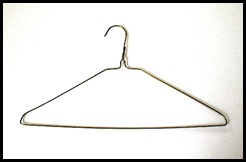 Hangers are ok to use for displaying clothes, but they’re among my least favorite options for storing clothing. It’s not just wire hangers; it’s any kind of hangers. I don’t have anything against them, it’s just that when I’m changing clothes, I don’t feel like hanging something up. I’m more of a “chair draper” than a “clothing hanger,” though I don’t mind hanging a sweater on a doorknob or even on a coat tree.
Hangers are ok to use for displaying clothes, but they’re among my least favorite options for storing clothing. It’s not just wire hangers; it’s any kind of hangers. I don’t have anything against them, it’s just that when I’m changing clothes, I don’t feel like hanging something up. I’m more of a “chair draper” than a “clothing hanger,” though I don’t mind hanging a sweater on a doorknob or even on a coat tree.

The point of all this is not to tell you that I’m too lazy to hang up my clothes. It’s to remind you that your wardrobe storage system needs to be functional for you – not just to look good for a magazine photo. If it’s not convenient for you to use, you just won’t use it. The problem isn’t that you’re not complying with the design of a particular storage system, it’s that the storage system needs to reflect your personal style for putting things away.
Astute parents know that if they want their children to put things away, there needs to be a designated place for things to go, and it needs to be easy to put them there (and to get them back out). What’s good for children, turns out to be a good design for adults too.
Before the invention of the hanger (various versions were patented between 1869 and 1920), there were no closets for hanging clothes.  If you’ve ever been through an original house built before 1920, you won’t find any clothes racks, and possibly not even a designated storage space for storing garments (that’s what wooden wardrobes were designed to do). Obviously, people owned fewer garments in those times, but for the few garments that weren’t folded (including coats) there were pegs or hooks for storing them. Before there were hangers, there was no need for hanger rods.
If you’ve ever been through an original house built before 1920, you won’t find any clothes racks, and possibly not even a designated storage space for storing garments (that’s what wooden wardrobes were designed to do). Obviously, people owned fewer garments in those times, but for the few garments that weren’t folded (including coats) there were pegs or hooks for storing them. Before there were hangers, there was no need for hanger rods.
Pegs or hooks are still the coat-hanging devices of choice for kids’ coats at school. Backs of chairs also seem to attract jackets and sweaters at my house. While they may not be ideal for storing fine clothing that is infrequently worn, hooks are terrific for outer garments and clothing items that go on and off several times throughout the week. Coat trees, rows of hooks near a doorway, and single hooks on the backs of door provide situational options of the hook theme. I am also a big fan of using a valet (the more elegant alternative to the back-of-a-chair option), especially for laying out the next day’s outfit to wear. Using a valet has the added benefit of creating a sense of dignity and importance to one’s clothing selection and their appearance, in general. It evokes that same sense of confidence that comes from donning a special interview outfit, and extends it to your daily dressing routine.
also a big fan of using a valet (the more elegant alternative to the back-of-a-chair option), especially for laying out the next day’s outfit to wear. Using a valet has the added benefit of creating a sense of dignity and importance to one’s clothing selection and their appearance, in general. It evokes that same sense of confidence that comes from donning a special interview outfit, and extends it to your daily dressing routine.
Folding clothes to store in drawers or on shelves is another alternative to hanging clothes from a rack, but it only works well for putting clothes away. If clothes are folded and stacked in a drawer, you can only see the items on top. Folded stacks on a shelf improves the view, but still results in difficulties if you try to pull out something from further down the stack (and don’t even think about trying to replace an item back in the stack where you found it).
 The folded clothes solution that I find most effective is to reduce the height of the stacks. On a shelf, three is an acceptable stacking height, but if you can have a separate divider shelf between each garment, that would be the best. In a drawer, I use a fanned stacking method. It allows for full visibility, and a fair means of accessibility and replacement, even if you can’t store as many items per drawer.
The folded clothes solution that I find most effective is to reduce the height of the stacks. On a shelf, three is an acceptable stacking height, but if you can have a separate divider shelf between each garment, that would be the best. In a drawer, I use a fanned stacking method. It allows for full visibility, and a fair means of accessibility and replacement, even if you can’t store as many items per drawer.
While I’m on the topic of clothing storage, let me remind you to beware the allure of novelty storage units and organizing devices. They look very cool in the catalogs (though if you look observantly, you’ll notice that they are demonstrated with a minimal amount of items in them, and the sellers seem to select items that will fit the organizers, rather than designing the organizers around the items to be stored). If you really think a storage system will work for you, try out a prototype first. Instead of buying a set of plastic sock dividers, cut up cardboard tissue boxes (or whatever replicates the design of the manufactured item), and try out your makeshift prototype for a while to see if it really works as well as you imagined. If an organizing device is well designed and functional, and it actually helps you keep things organized, it could be worth the money. But if you buy it because you think it will motivate you to get things organized and maintain order, but it clashes with your personal style, you’re risking a waste of your money with the potential purchase of a white elephant.

If you are up to the ultimate challenge of wardrobe organization (or even if you just aspire to meet it someday), try designating part of your storage space for emptiness. That’s right. Could you even fathom the thought of having an empty drawer in your dresser? It may seem like some unattainable fantasy, but it could happen. Try it on for size. Empty out the contents of a dresser drawer, then close it up. Open it and just savor the expanse of emptiness before you. It’s not wasteful. It’s good feng shui. It’s making room for good things to come into your life. An empty hook on a coat tree and an empty drawer in your dresser … organizational bliss.
Posted in Mindful Spending, Organization, Personal Style, Spaces & Things | Tagged: accumulation, awareness, closet, clothes, clothing, coat tree, coats, collections, design, drawers, dresser, efficiency, empty drawer, fanned stacking, feng shui, follow through, garments, hangers, hooks, image, intention, jackets, Maintenance, mindful, Momentum, Motivation, Organization, organized closet, organizing, outfits, Personal Style, Procrastination, Productivity, prototype, reality check, self-confidence, self-discipline, system, valet, wardrobe | 1 Comment »
Posted by denisefisher on April 22, 2009
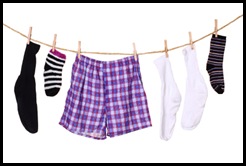 If you’re like most people, you probably have drawers bulging with a hodgepodge of underwear (in various stages of deterioration), a miscellaneous collection of socks and hosiery (the good ones on the top, and mismatched, holey ones stashed in the back). You are also likely to have closets full of coats, jackets, hoodies, etc. (you do buy new ones, but never seem to purge any of the old ones). Hats, gloves, mittens, and scarves? Same story (only with more cases of items separated from their mates). Add to that, swimwear, sleepwear, exercise clothing, belts, ties, and other accessories, and you’ve got a recipe for wardrobe chaos. These items make up what I refer to as the Secondary Wardrobe. They don’t receive the same attention as other garments, or even shoes, and as such, they’re not as likely to be purged or organized either.
If you’re like most people, you probably have drawers bulging with a hodgepodge of underwear (in various stages of deterioration), a miscellaneous collection of socks and hosiery (the good ones on the top, and mismatched, holey ones stashed in the back). You are also likely to have closets full of coats, jackets, hoodies, etc. (you do buy new ones, but never seem to purge any of the old ones). Hats, gloves, mittens, and scarves? Same story (only with more cases of items separated from their mates). Add to that, swimwear, sleepwear, exercise clothing, belts, ties, and other accessories, and you’ve got a recipe for wardrobe chaos. These items make up what I refer to as the Secondary Wardrobe. They don’t receive the same attention as other garments, or even shoes, and as such, they’re not as likely to be purged or organized either.
Purging with a Plan
Most of the clutter problem can be eliminated by emptying any given drawer, coat rack or storage shelf of its contents and returning only those items that are keepers. The concept is simple; the execution … not so much. Ideally you would create a plan for the type of items you need for each occasion (a la the Packing for Paris technique) and you would determine an acceptable number of items to have in any given clothing category (a la Organizing by the Numbers). If you were especially efficient or ambitious in your wardrobe planning, you’d designate one third of each clothing category to be replaced each year (a la the 3-year Wardrobe Plan). But at the very least, emptying your clothing storage spaces (one manageable unit at a time), trying on what you have and assessing the value of each item (a la Get Naked and Get Real) is better than nothing. After separating the keepers from the tossers, the crucial remaining step would be to dispose of the purged items appropriately (a la What To Do With What You Don’t Wear).
I figure you’re smart enough to cull through your secondary wardrobe items and bring enough order to your collection that it becomes, at least, tolerable. But I do have some suggestions for managing the lifecycles of your socks and underwear.
Buy/Keep Only the Best Socks & Undergarments
Undergarment preferences are very personal and strongly opinionated. You know what styles, fabric, colors, and other features you want for the items you wear everyday. So then why do you have so many items in your drawers that you don’t like or never wear? How did you amass such a hodgepodge of items that don’t conform to your strict standards of quality and personal preferences? It could be a combination of purchases others made for you, impulse purchases, or disappointed expectations from what you thought you were buying. Determining the cause is only important for purposes of awareness in future situations. For me, the biggest problem in having a fully functional selection of intimate apparel (and even for shoes and other garments) has been caused by my settling for what’s available when I’ve not been able to find exactly what I’m looking for.
Eureka in Quantities
That’s why I’m passing along this advice to you. When you find the perfect underwear, socks or other garments or accessories for which you buy multiple items, buy them in quantities! Keep your color selections to a minimum and stock your drawers with your find of your favorite style. If you find the perfect sock – cotton blend, knee-high, and reinforced toes and heels that aren’t made of a contrasting color – buy a load of them. Buy 7 black pair, 7 navy pair, 4 brown pair, and 3 dark green pair. These are your socks – you’ve found them. Skip the  herringbone knit, ignore the mid-calf length, and don’t even consider the novelty prints or fun colors on the rack. The bonus benefit of buying multiple pairs of the same socks is that you will have fewer stray singles – instead of two unmatched socks, you’d now have a matching pair.
herringbone knit, ignore the mid-calf length, and don’t even consider the novelty prints or fun colors on the rack. The bonus benefit of buying multiple pairs of the same socks is that you will have fewer stray singles – instead of two unmatched socks, you’d now have a matching pair.
Identify Your Perfect Undergarments
The same thing goes for underwear – and options for women add even more layers of complication to the equation. As you realize your specific preferences, write them down to create a list of criteria that your purchases must meet. You’ll most likely only have a few of these type of lists, but once you’ve determined your qualifying preferences, declare it in writing, add your descriptive list to your wardrobe portfolio (you DID get a pocket folder for this purpose, didn’t you? seriously, it’s worth having), and you will be able to recite your preferences to any clerk who asks how they can help you, or use your descriptive criteria as a checklist when looking for purchases online.
Use That Wardrobe Portfolio
As I’ve mentioned before – and it’s especially pertinent for this situation – when you’ve found the perfect item, note where you found it and the price, along with the exact size, manufacturer, style name/number, and any other identifying features. It’s not always easy to find the perfect item that meets your standards, so once you’ve located it, make a note of it so you don’t have to start your next search from scratch. And see? This is another use for your wardrobe portfolio. Where else are you going to store this information and be able to find it the next time you need it? Don’t rationalize – just get the folder and put one piece of pertinent information in it (a clothing receipt, for example). You’ll suddenly find uses for it that you hadn’t thought of before you had it.
Fits Like a Glove
I have one more suggestion on the topic of underwear fitting and purchases, and this one’s for women. If you’ve ever watched some of the wardrobe makeover shows on TV, you’ll know that determining proper bra size can be an issue. Your size and most flattering style may have changed over the years, and maybe you haven’t made the adjustment. If you’re up to finding someone who can properly fit you, go for it. For the more self-conscious or self-reliant among us, use the sizing instructions and bra size calculator located at a website such as Linda, The Bra Lady (of the various sites that checked, I like her calculator the best): http://www.lindasonline.com/bra-school.html?gclid=CIaX-ubjg5oCFdhL5QodoBH1Fw
What’ve You Got Under There?
While you’re thinking about it, go take a look at your socks and underwear drawers. Also, check out your coat closet. Did I nail it on my speculative description? The grand finale step-by-step guide to organizing your wardrobe will be coming up soon. But for now, just be aware of the existing condition and be thinking about how you want to change it.
Posted in Organization, Personal Style, Spaces & Things | Tagged: accessories, accumulation, awareness, belts, bras, catalog, chaos, closet, clothes, clothing, clutter, coats, collections, drawers, fit, fitting, garments, gloves, hats, hoodies, hosiery, intimate apparel, jackets, lifecycle, makeover, mindful, mittens, Organization, organized closet, organizing, plan, Planning, portfolio, purchases, purge, quality, quantities, reality check, scarves, selection, shopping, size, sleepwear, socks, storage space, style, swimwear, ties, undergarments, underwear, wardrobe, wear, your look | 2 Comments »
Posted by denisefisher on April 17, 2009
 Purging one’s possessions is not as easy as it would seem. There are mental blocks and rationalities that make this task difficult. We get attached to our stuff and tend to overvalue things that we own, even when we’re ready to part with them. The value we see in our inactive wardrobe items generally falls into one or more of these categories:
Purging one’s possessions is not as easy as it would seem. There are mental blocks and rationalities that make this task difficult. We get attached to our stuff and tend to overvalue things that we own, even when we’re ready to part with them. The value we see in our inactive wardrobe items generally falls into one or more of these categories:
- Utilitarian Value
I don’t want it, but it’s too good to throw out.
- Monetary Value
This is worth some money.
- Inherent Value
I would wear this if it still fit me. Do you want it?
- Sentimental Value
Aw, I remember when I wore this. OR I can’t throw this out – it’s my lucky hat.
- Salvage Value
I can’t wear this anymore, but I really like the fabric (or trim or some other feature). I wish I could do something with it.
When making these tough decisions about what to do with what you don’t wear, it helps to have options. If you have options, you can take action. It will get you unstuck if you’re frozen in a state of indecision. Here’s are the options I came up with to address the values we want to maintain:
Sell it – Consignment Store, E-bay, Craig’s List, Garage Sale
Donate it – Non-profit Organization/Thrift Store (for tax deduction)
Give it away – Hand-me-downs, Clothing Swaps, Freecycle.com, Organized Events, Theater Wardrobe, Random Giveaway
Repurpose it – Alterations or New Use (pants to shorts, long skirt to short skirt), Relegate items to categories of work clothes or costumes
Salvage it – Make it into a new textile item (quilt, comforter, picnic spread, pillow), cut it up for rags, use it for pet bedding
Save it – Display it, Store it as an archive/heirloom
Trash it – Last resort option for unusable items taking up space
If the options seem a bit overwhelming and you need a reality check to assess your options, you might try a rating system. From the options suggested above, list the specific options that you’d honestly consider acting upon. Next to each option listed, use a five-level rating system with these icons, to evaluate which options are best:
$ Financial benefit (a definite plus)
* Time & effort involved (a possible detraction)
@ Space needed to work on or store items (a possible detraction)
+ Your satisfaction with that particular option (a definite plus)
# Likelihood that you’ll follow through and finish (the determining factor)
By creating a rating system, you can explore each option separately, using the icon factors on a scale of one to five ($$$$$ next to the option of consignment shop or e-bay would indicate a substantial sum of money could be earned if you chose that option). Then you can compare the composite ratings to see which options are most realistic for you. The trump card lies in your likelihood to do (and finish) whichever option you favor. Even if a garage sale would net you a tidy profit, and you’d be happy with the outcome, scratch it off the list of viable alternatives if you know you’re not likely to get it done (despite your good intentions). You’ve still got other alternatives, and you can save the garage sale option for your next round of closet organizations, when your life is more orderly.
For some people, this exercise is a no-brainer. No need to make this task difficult or complicated. They limit their options and require little deliberation to decide and then act. But for others, the process is excruciating and time consuming. It’s better to have options and some kind of assessment process (even if it may seem overly elaborate) than to remain indecisive and action-averse. The good thing about thinking through this decision-making process, and coming up with what works for you, is that it is a skill that you will reuse and strengthen through practice. You’re not going to clear out your closet once and be done with it forever. So it can be worth the time and effort to make a major production out of it once, so that you can confidently take action and learn to hone your process through repetition.
What happens to clothing I donate?
I have read a lot of misinformation about what clothing is acceptable to donate to charitable organizations and where it it ends up. I’ve heard “experts” admonish readers not to donate clothing that’s out of fashion or unsuitable to wear, and I’ve heard others talk about how they donate items to clothe the poor and homeless. Both of these perceptions are largely inaccurate and are explanations that are retold so frequently that they are presumed to be true. But most donors are so far removed from the people and the processes involved that they are simply ignorant and fill in the gaps of the story with ideal imaginings (similar to the way people imagine where meat and produce come from and what happens to trash and whatever is poured down the drains or sewers).

So, to get the story straight about donated clothing, I visited several thrift stores, talked to the managers, and called corporate offices. I was able to talk to some local and national organizations, for profit and non-profit, who could give me the scoop. Of course, there are variations to this process and its details, amongst the wide array of business models, but for the eight organizations that I checked out, the process was fairly typical.
1. For most non-profit (and even for-profit) organizations, they are basically running a full-time garage sale to take your donated items, sell them at a market price to whomever wants to buy them, take the liquidated proceeds and use that money to fund and administer their service programs. The organization to whom you make your donations is the cause you are supporting with your clothing contributions. Some clothing items are designated for unemployed career seekers who need interview outfits or for other select recipients. But mostly, it’s all sold to the public and turned into cash.
2. Clothing items are dropped off by donors at designated locations (usually at the thrift store location – many have specific hours where you can drop off items at the back, where someone will help you unload and give you a receipt). Alternatively, some organizations provide pick-up service – with calls initiated by the donor; though sometimes monthly calls are made by the non-profit organization from a calling list of regular donors. Other organizations will drop off collection bags with instructions and a designated pick-up date noted on the bag.
3. Collected clothing is sorted, priced, and arranged for display on racks or shelves in their thrift store locations. Many of the thrift stores use a color-coded price tag system that changes weekly, so they can tell how long an item has been on display without being sold, and the inventory can be rotated. Clothing is not laundered, dry cleaned, or repaired when put out for sale. Everything is displayed and sold “as is,” with no guarantees, no returns, and no exchanges.
4. Thrift stores are open to the public, and look similar to retail outlets. Typical shoppers are working class or middle class people. Most seem to be frugal-minded shoppers, not destitute or homeless, and once exposed to the thrift store offerings and purchase prices, many become regulars. Clothing in these stores is typically grouped by gender, type of item, and color, but not size. In most stores, there are fitting rooms, where shoppers can try on the items they wish to buy, to make sure they fit. Some of the clothing items do not have sizes labeled, so buyers have to make their best guess.
5. For those stores that use the color-coded price tag system, they will post a sign in a prominent location to indicate that a certain color price tag has an additional discount.

These items are on their last week of the inventory rotation. Whatever (yellow tag) items remain will be purged from the racks to make room for new arrivals that will be priced using a new round of yellow tags. Some stores offer additional discounts to students, military members, and seniors. Others feature a designated day of the week when additional discounts apply.
6. Clothing that does not sell (and some damaged items that are weeded out and never make it to the racks) are sold or given to a salvage company which picks up the unsold clothing and distributes it for other purposes. Some of the functional clothing items are distributed to organizations which eventually make their way to third world countries (have you ever seen news stories on TV and wondered why hungry children in Asia or Africa are wearing T-shirts with a logo that says Baby Gap on them? now you know). Other garments are cut into pieces, after having of fasteners and trim removed, and then baled into bundles and sold in bulk as rags for mechanic shops, painters, and other blue-collar industries. Some scraps are recycled with other textiles and fibrous materials to make packaging materials. I didn’t follow the lifecycle of these items into further detail, but this explanation should provide some insight into what happens to donated clothing, which most consumers wouldn’t be aware of.

Consignment Shops
Some consignment shops still use the sales model of displaying your selected goods in their stores with the hope of selling them and splitting the profit with you after the sale. But others are simplifying the process with a single cash-for-goods transaction up front. The simplified process reduces record keeping and follow-up, but requires a greater cash flow for the consignment shop and assumes greater risk. More cash is needed to pay for the inventory, and the owner could get stuck paying for items that don’t sell or that take up valuable store space for weeks and weeks, awaiting an interested buyer. But savvy shop owners become skilled at knowing what items will sell and how much shoppers will pay; and the consignment donors will settle for a lower percentage of the expected profit in exchange for cash in hand.
So the “cash upfront” model has replaced many of the original consignment models, and added a modified twist to the process. I spoke to Valerie at a store called Plato’s Closet – a national franchise whose target market is the fashion-conscious teenage girl demographic. Valerie explained that they use a pay-on-the-spot payment model for their consignments. They accept current fashions (within the past two years – hey that would coincide nicely with the 3-year wardrobe plan) of teen clothing and pay you 1/3 of retail price for items in excellent condition. For items over $20, they pay you half of retail price. A photo identification is required for the transaction, but cash is paid for the items, up to $60 (if the amount is above $60, a check is given as payment). The prices and conditions are somewhat negotiable, and the store claims to work with the consignment donor to reach a fair price. For items that don’t sell, Valerie told me that they are picked up by the Salvation Army, and get a second chance for purchase at a thrift store outlet.
Though I doubt readers of this blog would be teenage girls who had never heard of Plato’s Closet (if there was one in their area), you might be the parent of such a teenager or a pre-teen, and would appreciate an explanation of what these shops are and how they work. Even if the Plato’s Closet store has no relevance to you, it still might be helpful for you to know about such places. Then you can look up stores in your area and not be intimidated by your unfamiliarity with them, should you choose to pursue consignment shops as an option. Just call one, tell them that you are new to consignment stores (or thrift shops) and ask them how their processes are set up.
So now you know how thrift stores and consignment shops work. And you can consider these among the other options I mentioned, which might be more familiar to you. When you decide that you are ready to do your wardrobe reorganization, you will need to have a plan in place for how to handle the clothing and other items you want to purge. So it’s good to begin considering your options now, and start thinking about what to do with clothes you don’t wear.
Posted in Finances, Organization, Personal Style, Spaces & Things | Tagged: accumulation, alterations, assessment, closet, clothes, clothing, clothing swaps, clutter, collections, consignment shops, contribution, decision making, discount, donation, eliminate, financial benefit, finish, follow through, garage sale, garments, hand-me-downs, lifecycle, makeover, Momentum, Motivation, non-profit, organized closet, organizing, plan, Planning, Plato's Closet, possessions, price tag, process, Production, purge, rags, reality check, repurpose, resell, Salvation Army, stuff, system, tax deduction, textile, thrift stores, value, wardrobe, wear | 4 Comments »
Posted by denisefisher on April 13, 2009
 I’ll avoid the inclination to call it a debate, and skip the obvious cliché references to Imelda Marcos or other celebrities, but I think it’s clear – managing one’s shoe collection is tough. “How many pairs do you need?” and “Where and how should you store them?” are subjective questions to consider. Shoes and other footwear present a special concern when organizing a wardrobe. Mainly because of the storage issue. There are so many different sizes and shapes of footwear that they don’t lend themselves to uniform storage. Boots, flip-flops, high heels, and high-top tennis shoes – where do they all fit?
I’ll avoid the inclination to call it a debate, and skip the obvious cliché references to Imelda Marcos or other celebrities, but I think it’s clear – managing one’s shoe collection is tough. “How many pairs do you need?” and “Where and how should you store them?” are subjective questions to consider. Shoes and other footwear present a special concern when organizing a wardrobe. Mainly because of the storage issue. There are so many different sizes and shapes of footwear that they don’t lend themselves to uniform storage. Boots, flip-flops, high heels, and high-top tennis shoes – where do they all fit?
Shoe Storage Practicality
I’ve seen all the various shoe racks, over-the-door pocket hangers, inclined shelving, and divided storage compartments that are shown in catalogs – I’ve even tried many of them – but unless you only have the type of shoes that are pictured in the displays, they’re not going to work. Shoe storage units are not adjustable to accommodate various types of footwear, and yet, your footwear styles and selections change annually, if not seasonally. I’ve determined that the easiest, most practical way to store shoes is to line them up in a row on the floor – where you can visually scan what you have, identify the pair you want, and access what you need. That’s the way people intuitively store them anyway. But it doesn’t take many pairs of shoes to use up all available floor space (hope you weren’t planning to store your luggage, laundry basket, or gym bag on your closet floor), so then what?
Planning Your Footwear Number
Again, you’re going to have to use the Packing for Paris mindset (selecting only the best – the items you’ll actually wear for you lifestyle’s occasions – to keep in the amount of space that’s available), and employ the Organizing by the Numbers technique (determine your wardrobe categories and designate the ideal number of items allowed for each season, and make this determination separately from your viewing of the items you already have).
This is a personal decision you’re going to have to make (hence the dilemma). You’re going to have to think about it ahead of time – before you start organizing – not when you’re in the midst of sorting through a pile of shoes in the middle of your bedroom floor, as you realize you’ve got more inventory than warehouse space, and you’re getting tired of deciding what to do with all the clutter you’ve emptied from your closet. Because we all know what will happen to the pile of shoes then – say it with me everyone – it will all get dumped back into the closet. Like every other project you undertake (and another one of my favorite mantras), you need to separate the planning from the execution.
Footwear Reality Check
So, let’s think about how to imagine you’re packing for Paris and organize shoes by the numbers. Oh, and one more thing – you’re also going to need to try on each pair of shoes you intend to keep, wearing the type of socks or hosiery that you’d typically wear with each pair of shoes or boots. And yes, you’ll need to put on both shoes and do a few runway walks across the floor to refresh your memory (and your feet) about the comfort and practicality of the footwear items you currently own. No one would intentionally pack a pair of shoes to wear for a night on the town in Paris if they couldn’t bear to keep them on their feet for 6-8 hours straight would they… (and I hate to generalize, but…) ladies? Life is too short, days are too long, and closets are too small for footwear that hurts your feet or makes walking difficult, no matter how great they look. If you insist on sacrificing comfort and practicality for fashion, at least try to limit your impractical “posing” footwear to no more than 20% of your total shoe collection.
Footwear Allowance – By Season and Occasion
In creating my footwear wardrobe categories, I’m using a similar process that I devised for determining types of outfits that match up with my lifestyle and various activities. I’ve also expanded this list to include special purpose footwear that may be worn infrequently, but for which there is no practical substitute. In the case of footwear, I divide the seasons into cold weather (Winter/Fall) and warm weather (Spring/Summer). Here are my lists, arranged by season (* indicates special purpose footwear):
| Fall/Winter |
Spring/Summer |
| everyday shoes (casual) |
everyday shoes (casual) |
| everyday shoes (nicer) |
everyday shoes (nicer) |
| presentation shoes |
presentation shoes |
| dress-up shoes |
dress-up shoes |
| working shoes |
working shoes |
| around-the-house “default” shoes |
around-the-house “default” shoes |
| *house slippers |
*flip-flops |
| *exercise shoes |
*exercise shoes |
| *dance/sports shoes |
*dance/sports shoes |
| *snow boots |
*water shoes |
Create your inventory allowance numbers for each activity category before you survey your existing shoe collection. You can give yourself a one- or two-pair pass or waiver (a bonus allowance, if you will) to allow for a rare exception to your number limitation. But decide on the number of exceptions you’ll allow before you start your survey assessment or you’ll end up with more exceptions than the rule.
My goal is to have one pair of footwear for each of the categories shown in the list, with a two-pair bonus pass for whichever miscellaneous shoes I want to keep, beyond the limitations of the list. I’m actually in a shoe deficit, with regards to the goals of my list. I have particular preferences in my shoes that make it hard to find what I want. When I add to that issue, certain fitting problems that I have, I find myself seriously considering custom-crafted footwear. I’ve already added a list of potential sources and styles to my wardrobe planning portfolio.
Shoe Storage Determinations
Once you’ve determined your categories, seasons, and numbers, you’ll also need to consider your storage space. If your active wardrobe space is limited, you have basically three alternatives:
a) store out-of-season footwear somewhere else, and rotate your collection
b) store your least-worn or specialty footwear elsewhere in your room or in the house (e.g. boots in the coat closet, dance/sport shoes in your gym bag, house slippers by your nightstand, dress shoes in a box on the closet shelf)
c) pare down your collection so that you can store it in an orderly way in the space you have
I have too many shoes (and too small a closet) to keep my footwear all in one place, so I have to store some of them elsewhere. If I still have the boxes they came in, I like to use those. For others, I put each pair in a separate plastic grocery bag (if you can, make it easier to tell what’s inside by color coding the plastic bags you use with the type of shoe – white for dressier shoes, brown for everyday casual or work shoes – that will help if you need to dig out a stored pair of shoes in the off-season). I then stack the bagged shoes into an oversized plastic storage bin, label it, and stack it with other labeled bins in which I store other seasonal clothing.
The Favorite Shoes Showcase Game
Try this exercise to think about what you find most practical in your footwear. It may help you when purging your shoe collection and when planning future purchases. Actually, you might want to try this exercise in reverse, using a process of elimination; but try it, one way or the other.
If you could keep only one pair of shoes…
 (This is the pair of shoes from my collection that I’d choose if I had to select just one pair to suit every shoe-wearing occasion.)
(This is the pair of shoes from my collection that I’d choose if I had to select just one pair to suit every shoe-wearing occasion.)
You’d want comfort, versatility, and all those things that make a wardrobe item worthy of its closet real estate.
If you could keep (or pack) only three pair of shoes…
 (These would be the three pairs of shoes I’d choose from what I currently own to cover the broadest range of situations. Notice that the pair of shoes I chose as my one all-purpose pair have been replaced when given the option of choosing three pairs.)
(These would be the three pairs of shoes I’d choose from what I currently own to cover the broadest range of situations. Notice that the pair of shoes I chose as my one all-purpose pair have been replaced when given the option of choosing three pairs.)
You’d probably be considering the most versatile shoes you owned that could be worn with the broadest number of outfits and suitable for the widest range of activities.
Another thing you might realize from doing this task (especially if you take photos of them to post on your blog) is that one or more pairs of your favorite shoes may be in need of maintenance or replacement.
Try the Shoe Estimating Challenge
I’ve got a few more posts to make on the topic of wardrobe organization, before the grand finale of this series, but go, take a look at your footwear collection to see what three selections would make it to your favorites showcase. Before you go to look at all the shoes you have, take a guess at how many pairs you have. Then do a quick count to see how close you are (don’t forget the pairs by the door, next to the dresser, in the coat closet, under the bed, and out in the garage or mudroom. If there are other family members or housemates living in your abode and you want to make it interesting, try challenging them to a footwear guessing game. Someone could get a free shoe polishing (or maybe a foot massage) out of it.
Posted in Mindful Spending, Organization, Personal Style, Spaces & Things | Tagged: accumulation, boots, catalog, choices, closet, clothing, clutter, collections, custom clothing, dance shoes, decision making, design, dress-up, eliminate, everyday, exercise shoes, fashion, fit, flip-flops, footwear, high heels, house slippers, image, importance, intention, makeover, mindful, Motivation, numbers, Organization, organized closet, organizing, outfits, pack for travel, plan, Planning, portfolio, possessions, project, purge, quality, reality check, seasons, shoe maker, shoe storage, shoes, shopping, sneaker, space, sports shoes, storage space, style, tennis shoes, versatility, wardrobe, water shoes, wear, your look | Leave a Comment »
Posted by denisefisher on April 2, 2009
 This concept is partially inspired by what frugal finance author, Amy Dacyczyn termed “the 3-year sneaker plan.” In her plan, she would purchase a new pair of sneakers every year. These new sneakers would be worn when she was going someplace where she wanted to look casual but nicely presentable. Her last year’s “new” sneakers, upon the purchase of this year’s new pair, would be relegated to the status of her everyday shoes – ones she would wear around the house most days of the week. The oldest of her 3-pair sneaker collection (the ones that had been last year’s everyday shoes) were assigned the status of work shoes. Those would be the ones she wore when doing gardening, yard work, painting, and such. And her last year’s work shoes, having fully served their life expectancy as functional footwear, were summarily tossed into the trash.
This concept is partially inspired by what frugal finance author, Amy Dacyczyn termed “the 3-year sneaker plan.” In her plan, she would purchase a new pair of sneakers every year. These new sneakers would be worn when she was going someplace where she wanted to look casual but nicely presentable. Her last year’s “new” sneakers, upon the purchase of this year’s new pair, would be relegated to the status of her everyday shoes – ones she would wear around the house most days of the week. The oldest of her 3-pair sneaker collection (the ones that had been last year’s everyday shoes) were assigned the status of work shoes. Those would be the ones she wore when doing gardening, yard work, painting, and such. And her last year’s work shoes, having fully served their life expectancy as functional footwear, were summarily tossed into the trash.
By using a 3-year plan, one’s wardrobe (or sneaker collection) could be systematically recycled and replaced in its entirety every three years – one third at a time.
Imagine your own responsible wardrobe plan that includes the purchase of 7 new outfits every 4 months. Not 7 clothing items, 7 complete outfits (except probably not including 7 new pairs of shoes). The catch? There are two:
1) There needs to be a true plan.
This concept is not meant to condone a free-for-all impulsive shopping trip to buy whatever miscellaneous clothing items you find on sale, to indulge in purchases of items that are “cute,” nor to buy clearance garments that you happened to find in your size and were unable to resist. There needs to be a responsible, thought-out plan. But don’t let the requirement of a plan take the fun out of it. The planning should be part of the excitement and anticipation of the process, in the same way that planning a trip can be almost as much fun as the actual adventure.
2)You need to purge 7 outfits from your wardrobe.
You knew this was coming. But ask yourself this question: could you find 7 outfits in your seasonal collection (whichever season it happens to be) that you’d be willing to part with if it meant replacing them with new clothing items? You might not even have to get rid of your comfortable pullover shirt that fits so perfectly and the distressed denim jeans that you always wear with it, even if they’re both starting to look faded or worn at the seams. Perhaps you can move that outfit into your “work clothes” category, and instead, purge your collection of that well-worn outfit that you wear for hiking muddy trails in the woods.
Wardrobe Replacement by the Numbers
Using my previous example of the 28-outfit seasonal wardrobe, let’s see how the 3-year wardrobe plan might incorporate a 7-outfit purchase plan. Keep in mind that the basic idea is to replace one third of your wardrobe every 3 years, so that no item in your collection is more than about 2 years old.
To break out the 7-outfit allotment of one season’s collection, by category, it might look something like this:
|
Outfits To Purchase
|
Category
|
Total Outfits On Hand
|
Number To Purge/Repurpose
|
|
1
|
Presentation Outfit
|
4
|
1
|
|
1
|
Dress-up Outfit
|
3
|
1
|
|
5
|
Everyday Outfits
|
14
|
5
|
|
0
|
Work Outfits
|
7
|
5
|
|
7 total
|
|
28 total
|
7 – to purge
5 – to repurpose |
The term “repurpose” is used here to refer to garments which are kept and reclassified within your own wardrobe (e.g., moving an everyday outfit into the category of work outfits). The word “purge” refers to garments to be removed from your wardrobe. Such purged items would generally be sold, donated, or given to someone you know.
Advice to Those Likely to Shop Too Much
- You don’t have to purchase 7 new outfits. By purchasing fewer clothes, you can save money, keep classic favorites, reduce and simplify your wardrobe space. Perhaps you can select fewer items, and focus more on high-quality goods and classic styles.
- You don’t have to buy new outfits. You can obtain clothing items (or entire outfits) from thrift stores, consignment shops, through clothing swaps or hand-me-downs, or by having used clothing items altered.
- You don’t have to buy mass produced outfits from outlets or discount stores; neither should you restrict your shopping to the sales racks of boutiques or department stores. Clothing can be designed and/or sewn by a) yourself, b) an aspiring designer, or c) a tailor/seamstress. The point is to avoid buying clothes that you don’t absolutely love, and to refrain from buying garments that don’t fit quite right, just because they’re bargain priced. Mass quantities of merchandise often induces mass quantities of purchasing (just ask shoppers of warehouse clubs).
Advice to Those Likely to Shop Too Seldom
- If you are the type who rarely replaces the contents of your wardrobe, maybe you do need to buy 7 new outfits. At the very least, you probably need to purge your closet of clothing that is no longer fresh looking (too worn, too faded, too fraught with stains, beyond maintenance or repair, or too out-of-date).
- If you tend to be unaware of personal aesthetics and what styles look good on you, your wardrobe assessment might be more effective if done with the assistance of a fashion consultant. Your consultant doesn’t have to be Tim Gunn, but you might want to solicit the services of a fashion-savvy partner, friend, or family member. You know the type (they’re the ones who always comment on what you’re wearing and how you look – good, bad, or some combination thereof).
- Watch out for tendencies to get stuck in a fashion era or to become complacent or apathetic of your clothing selections and appearance. You don’t need to abandon your own personal sense of style in the way you dress. And you don’t need to stay on the cutting edge of the latest fashion trends of the day. Instead, you need to select styles mindfully and be aware of current and classic clothing styles that enhance your appearance.
- You may be able to find fashion assistance at the stores in which you shop for clothing, or you might seek out the services of a professional wardrobe- or image-consultant. Such advice is very subjective, so don’t pursue this option lightly. Look for ways to balance your own sense of personal identity with an openness for contemporary design and style. The point is for your wardrobe selection to be intentional, rather than mindlessly assembled without thought.
Looking at the Financial Numbers
It might seem like I’m making a major production out of this wardrobe assessment and creating a purchase plan. But let’s consider this project in terms of price, to show how the costs add up. Assuming an outfit might include 3 clothing items, let’s examine three pricing scenarios and total the cost of 7 replacement outfits for each of 3 seasonal collections, over the course of a year:
| $20/item x 3 = $60 per outfit |
$60/outfit x 7 outfits = $420 per season |
$420/season x 3 seasonal collections = $1260 per year |
| $50/item x 3 = $150 per outfit |
$150/outfit x 7 outfits = $1050 per season |
$1050/season x 3 seasonal collections = $3150 per year |
| $100/item x 3 = $300 per outfit |
$300/outfit x 7 outfits = $2100 per season |
$2100/season x 3 seasonal collections = $6300 per year |
It would be wise to have a target spending amount available for acquiring new wardrobe items. Defining the numbers that determine your spending objectives lends credibility to your calculations and makes your projections more realistic. From there, you can make financial adjustments accordingly, and choose how to affect those adjustments.
More Reasons for Creating a Thoughtful Wardrobe Plan
Planning your wardrobe and future clothing purchases has more than a financial benefit. You select clothes to wear every day, sometimes making outfit changes multiple times throughout the day. There is importance in this planning – it’s not some kind of foofy, girly indulgence – your wardrobe is a reflection of you, a part of your self-image, and a factor in how you are perceived by others. Here are some of the other benefits of effective wardrobe planning:
- Efficiency in organization and use of storage space. Wardrobe planning reduces physical clutter and reduces the mental stress of chaos and disorganization. Good feng shui.
- Planning your wardrobe incorporates multiple tasks into a big picture project. Thinking about the many aspects of a well-planned wardrobe causes you to make good choices up front, in a coordinated effort. It reduces future occasions of indecision, over-thinking, excessive trying on of outfits, and piecemeal efforts at clothing organization.
- Conscientious selections reduce maintenance, including the costs and efforts associated with dry-cleaning, pressing, storage, and the arrangements needed to procure professional services.
- Mindful and intentional choices in purchasing avoid impulsive, short-sighted, rushed, or ill-advised spending decisions.
- Well-chosen clothing items improve your appearance. It affects how you feel about yourself, contributes to your self-confidence, and affects how others treat you.
- The very act of taking control of the possessions in your wardrobe gives you a sense of self-direction in your life, which spills over into other areas of your life. This makes the project worth the conscious effort and reflects the inherent importance of these tasks and their intentional purposes.
How to Plan Your Future Wardrobe Purchases and Purges
Start with a wardrobe portfolio. A binder or colored folder with pockets works well to start collecting your wardrobe plans. Use your portfolio to establish a wish list. Add pages from catalogs or magazines that show outfits and styles that you like (make sure that you keep the source information with the pics so that you’ll know where the info came from). Cut and paste pictures and ordering info from websites to create wardrobe collages that you can print out and put in your portfolio.
Include sketches of your ideas, and notes from personal observations. When you’re ready to go shopping or go online to place clothing orders, you’ll have your collected visions all in one place.
Keep a bag, laundry basket, or similar container handy to act as a recycling box for clothes you definitely or possibly may want to ditch. Use it when you put on a garment and notice it doesn’t fit, doesn’t look so good anymore, has a flaw not worth dealing with, or decide that you just don’t like it anymore. When you get a call for clothing donations or when you’re ready to do a wardrobe purge, you’ll already have a good start. Because this is an ongoing process, it’s worth making space in your closet for that recycling container.
Making the Purchases or Acquisitions
Keeping track of random clothing purchases, made over the course of 3 or 4 months, can be tricky, even if you have a general plan in mind. Create a chart or checklist of your intended purchases and keep it in your wardrobe portfolio. You might want to include an envelope (or use the portfolio pockets) to keep your purchase receipts, which will not only provide a reminder of your acquisitions, but will help you track your clothing-related spending.
I suggest making your wardrobe purchases a special event. Depending on your time availably and shopping preferences, this could be from 1 to 4 separate events. Each event might consist of an hour or two, or it might continue over a span of several days. Once you define the objective of the event, continue to pursue it until your mission has been accomplished.
- 1 event – buy all 7 outfits in one day, or over the span of several sequential days – one continuous mission
- 2 events – buy 2 outfits (1 presentation outfit, 1 dress-up outfit);
then buy the remaining 5 (everyday outfits) on a separate occasion
- 3 events – buy 2 outfits (1 presentation outfit, 1 dress-up outfit);
buy 2 nice everyday outfits;
buy 3 casual everyday outfits
- 4 events – buy 1 presentation outfit;
buy 1 dress-up outfit;
buy 2 nice everyday outfits;
buy 3 casual everyday outfits
Plan in advance – at least the day before – when you’re going to go out shopping for your purchases, and decide which specific stores you will visit. Then dress up in something that looks good on you and includes footwear that will look appropriate with your targeted outfits. Wear clothes that are easy to change out of (bonus if you can wear items that will mix and match with the type of garments you will be shopping for).
If you are open to multiple sources for your acquisitions, I would suggest following the order listed below (from least expensive to most expensive; from take-it-or-leave-it to custom-made selections). If you can find a free or inexpensive clothing item (but only if you really love it and it fits your plan), it can be worth it to splurge on alterations or to buy more expensive items to complete the look. Just be careful not to buy things because they’re a good deal and you can’t pass them up. Acquiring too much stuff that you don’t need (even if the cost isn’t prohibitive) is not a good deal, and it can sabotage your entire plan, if you’re not vigilant. Dress for self-control. Plan your methods and approach.
1 ) clothing swaps or hand-me-down acquisitions
2 ) thrift stores
3 ) consignment shops
4 ) discount or department store sales
5 ) online purchases from clothing retailers
6 ) high-end departments or specialty shops
7 ) tailor/seamstress/alterations services
8 ) designer/custom clothing or shoe maker
This whole purchasing technique will take some self-discipline and some trial and error for you to obtain the best approach. And you’ll probably need to mix it up from time to time, depending on what you’re looking for and opportunities you might discover. Keep in mind that creating new habits and following through on your plans are more difficult than slacking off into unproductive and undermining habits that contribute to piecemeal fixes and a less-than-optimally organized, cohesive wardrobe.
Start with your own observations and imaginings, and get a portfolio for collecting what you see and conceive. Take your time with the planning and make it an enjoyable project (plus, there are no expensive purchases involved in planning).
One final tip for in-charge, self-disciplined shopping. Walk tall and confident, like a person who knows what they want. Because that’s who you are. You’ve got a plan.
Posted in Mindful Spending, Organization, Personal Style, Routines, Spaces & Things, Time Management | Tagged: 3-year plan, accumulation, alterations, Amy Dacyczyn, awareness, catalog, choices, classic, closet, clothes, clothing, clothing swaps, consignment shops, consultant, cost, custom clothing, decision making, design, designer, dress, dress-up, eliminate, everyday, fashion, Frugal, garments, hand-me-downs, ideas, Maintenance, mindful, observation, Organization, organized closet, organizing, outfits, plan, Planning, portfolio, possessions, project, purchases, purge, quality, recycle, repurpose, seamstress, seasons, selection, self-confidence, self-discipline, shoe maker, shoes, shopping, simplicity, sneaker, space, Spending, stuff, style, tailor, thrift stores, Time, versatility, wardrobe, wear, worn, your look | 5 Comments »
Posted by denisefisher on March 27, 2009


The accumulation of stuff expands to fill the space available for its storage. And then it really picks up momentum.
As I wrote in my post, Packing For Paris, it’s better to think of your clothing items in the context of outfits, rather than individual garments. That assures that each of your clothing items goes with other articles of clothing or, perhaps, stands alone as its own outfit. This perspective also keeps you from having an imbalance of a particular clothing category. You can end up with far too many turtleneck sweaters or T-shirts for your needs (these surpluses can sneak up on you without you even realizing it), and these excess garments easily make themselves part of your permanent collection and while they’re seldom worn, they take up valuable real estate in your closet and dressers.
So it helps to have a plan for your wardrobe. And the most practical plan to implement is a plan with numbers. You can choose whatever numbers work for your situation. In reality, the numbers are fairly arbitrary. But choose the numbers first, and establish them as your wardrobe policy. This helps you avoid getting stuck or overwhelmed in your wardrobe assessment and organization project. You have enough decisions to make about what to keep and what to purge. Eliminate some of your decision-making by establishing a wardrobe quantity policy. It’ll be one less thing to have to think about.
I’m going to show you a generous wardrobe quantity policy that I developed for use in a temperate mid-west or mid-Atlantic climate that assumes a wide array of activities (and hence, a fairly wide array of clothing needs). This assumes a small quantity of “presentation” outfits (what you might wear to an interview or when making a presentation), a small quantity of dress-up outfits (what you might wear for a special evening out or for an afternoon wedding or graduation), a sufficient quantity of outfits for working around the house (clothing that you would wear when doing yard work or cleaning out the refrigerator – clothes that could sustain a permanent stain without you freaking out), and the remaining majority of outfits being “everyday wear” (this would vary from person to person, based on what your every day activities involved – it could even include “presentation” clothes or “work around the house” clothes if those are the activities that you usually do on most days).
Here’s how the numbers come out for my wardrobe quantity policy:
– 28 winter outfits
– 28 summer outfits
– 28 spring/fall outfits
That’s about one month’s worth of non-repeatable clothing outfits:
– 4 weeks of winter outfits
– 4 weeks of summer outfits
– 4 weeks of spring/fall outfits
For each season, I use this breakout:
4 presentation outfits
3 dress-up outfits
7 work around the house outfits
14 everyday outfits
28 outfits total
If each season lasts 3 months…
– January, February, March – winter
– April, May, June – spring
– July, August, September – summer
– October, November, December – fall
…And if the designated outfits are worn “evenly,” that means each outfit will be worn about 3 times per season.
Twenty-eight outfits per season (no repeats for a month) and only 3 repeats of any one outfit per season may seem excessive at first glance. But when I did my wardrobe assessment and reorganization, I reduced my clothing items by more than a third to reach these numbers. Unless you’ve done an inventory on your wardrobe, I expect that you will be shocked to find out how many garments you actually own. And remember, the number of 28 is for outfits, not individual clothing items. If your clothing items are fairly interchangeable, you’ll be able to mix and match them to create even more combinations. If the number that I’m using is too high for you, choose one that suits you better. The goal is to create a wardrobe policy that works for you.
Of course, the 28-outfit policy, in my example, requires that seasonal outfits designated for spring are recycled for wear in the fall rotation. This policy flouts the fashion industry’s rules regarding separate styles and colors for spring and fall, but who says I have to comply with their marketing ploys? That’s part of what created the problem of overstuffed closets in the first place. My spring-fall policy also means that this collection of clothing will get twice the wear of the other seasons, but the rotation won’t be back-to-back, and wearing an outfit six times over the course of an entire year isn’t at all unreasonable.
Keep in mind that the wearing schedule is totally tentative. Neither seasons of the year nor seasonable weather conforms to the calendar, so transitional adjustments will need to be made; and you may have to borrow from one of the adjacent season’s outfits when an unexpected heat wave or cold spell comes through.
The other thing to consider when establishing your wardrobe quantity policy is the space you have available for storage. Ideally, you will have room to store all of your clothing in the same general location (hopefully in the same room, except maybe outer garments, uniforms, or other specialty items). But if you need to rotate garments in and out of storage (in less convenient locations), I’d recommend keeping the spring-fall collection on hand and rotating out the winter and summer collections. That will allow you to make seasonal transitions more easily and will keep the adjacent season’s outfits available for those unseasonable weather days.
Go, take a look at your closet and dresser drawers, and do a quick count and estimate of your inventory. Then start formulating your own wardrobe quantity policy, by the numbers.
Posted in Organization, Personal Style, Spaces & Things | Tagged: accumulation, assessment, closet, clothes, clothing, collections, decision making, dresser, eliminate, everyday, fashion, garments, numbers, Organization, organized closet, organizing, outfits, plan, Planning, policy, project, purge, seasons, space, storage space, stuff, wardrobe, wear | 9 Comments »
Posted by denisefisher on March 25, 2009
 I have too many clothes. You have too many clothes. We all have too many clothes. Let’s just consider this one example: T-shirts. All colors, logos, sports teams, clever sayings, freebies from promotional campaigns or volunteer events. You probably have dozens more than you realize in your drawers right now. It’s hard to cull a collection to a manageable quantity because many of them are like new. The discerning qualities of fit, fabric, and style rarely apply – they’re nearly the same, from one T-shirt to another. So we keep them. All.
I have too many clothes. You have too many clothes. We all have too many clothes. Let’s just consider this one example: T-shirts. All colors, logos, sports teams, clever sayings, freebies from promotional campaigns or volunteer events. You probably have dozens more than you realize in your drawers right now. It’s hard to cull a collection to a manageable quantity because many of them are like new. The discerning qualities of fit, fabric, and style rarely apply – they’re nearly the same, from one T-shirt to another. So we keep them. All.
Who can blame us? It’s hard to purge items that are perfectly usable, even when you have more than you need. So, what to do? As with many productivity strategies, it’s mostly mental; it helps to make a game of it. One such wardrobe organizing game I like is a fantasy role-playing game I call Packing for Paris.
Imagine you’re packing your luggage for a trip to Paris. Even if it’s summer, and you over pack and assume that you won’t be laundering any clothes to re-wear, you’re not going to take your entire T-shirt collection with you. You only have so much luggage space, so you’re going to choose the best of what you own – the outfits with the best fit, the ones that are the most wearable, the most stylish, most versatile, needing the least maintenance, and the most practical for your travel lifestyle and the activities you’ll be engaged in. (Sound familiar?)
The reason why this game works is that it reverses the mindset from what you need to get rid of and instead, focuses on selecting the best of what you want to keep. When you assemble the outfits you want to pack for your travel destination, you don’t go through the contents of your wardrobe considering each item separately to determine what not to take. You start by imagining what types of activities you’ll be doing (traveling with luggage, site seeing in the city, dinner out, a day at the beach or the slopes, or hiking through the vineyards). You also plan your clothing choices for the climate and season (coats, boots, hats and gloves; jackets, pants, shirts with sleeves, and sneakers; or lightweight shirts, shorts, and sandals).
Once you’ve allowed for the climate and activities of your travel destination, you select appropriate footwear and select clothing items in groupings of outfits. Even if you have a great looking print shirt that fits well, is stylish, has low maintenance, and meets other criteria, if you don’t have anything suitable to pair it with (to complete an outfit) it’s not going to be a good clothing choice. You’re either going to need to buy a pair of pants, shorts, or a skirt that will go with this amazing shirt, or you’re going to need to pass.
Now, once you’re able to see the thought process that is used in Packing for Paris, you can use a similar mindset for assessing your wardrobe. Think of the limited space of your closet, dresser, and other storage units as the limited luggage space you have available. Don’t pack everything in and then try to determine what to eliminate. Same thing with your clothing storage spaces – clear them of their contents as if you’re starting with an empty suitcase. Then only put in the outfits that suit your needs and that you know you’ll wear. I’ll address what to do with the piles of leftover clothing and accessories on your bed in an upcoming post. For now, just read, absorb, and survey your situation. And imagine you’re going to be packing for Paris.
Posted in Organization, Personal Style, Spaces & Things | Tagged: closet, clothes, dresser, luggage, organized closet, organizing, pack for travel, Paris, purge, travel bag, wardrobe, wear | 4 Comments »
Posted by denisefisher on March 20, 2009
 To do a proper purge of your closet and dressers, you need to strip down to your skivvies; and if your purge includes swimwear and intimate apparel, you’re going to need to get naked.
To do a proper purge of your closet and dressers, you need to strip down to your skivvies; and if your purge includes swimwear and intimate apparel, you’re going to need to get naked.
The Plan
Over the next several posts, I’m going to talk about things to think about when assessing your wardrobe. At the end of the series, I’ll write out a step-by-step sequence for putting a plan together that you can execute. For now, just absorb and consider the mental preparations that will make this project successful for you. As I like to say, thinking about it is part of the process.
Getting the Big Picture
Before starting a massive wardrobe overhaul, it’s a good idea to survey the territory and get an overview of what you’re going to be dealing with. Take a look at all the garments, footwear, coats, and accessories you have stored throughout your home. Open closet doors, scan the racks, rods, hooks, shelves, baskets, boxes, and floor space that’s occupied by your wardrobe. Pull out the drawers of dressers, nightstands, armoires, and other storage units where your clothing is stored. Don’t forget under the bed (if you have storage there). What about clothing stored in other closets, coat racks, and seasonal storage containers? These might be in guest rooms, hallways, entryways, mudrooms, lockers, garages, basements, attics, or under stairways. If you’re going to do a total wardrobe makeover, you might as well organize all your clothing, wherever it’s stored. When you’ve finished, I doubt that you’ll say, “I wish I’d only organized the closet.”
Thumbs Down on the Rule of Thumb
I’ve read countless closet-clearing techniques over the years, and they usually mention some rule of thumb instruction stating that if you haven’t worn something within a year, get rid of it. I don’t buy it. I don’t think that’s the best determining factor. If I have a ski outfit which I spent a lot of money on, and hours of shopping to find, I’m not going to toss it because I didn’t wear it last year. Likewise for a sparkly gown that wasn’t worn to the ballet last season.
There are probably a few items in everyone’s closet that haven’t been worn in who-knows-how-long, but that shouldn’t be the deciding factor. If you want to get real about assessing the garments in your wardrobe, you have to try them on!
Your Own Private Fitting Room
You may have pleasant memories about a great looking sweater in your dresser. You may be thinking you’re waiting for the right occasion to wear it. But if, when you try it on, you’re reminded how it itches or how it exposes your midsection if you raise up your arms, that’ll be your reality check that it’s time to pass it on.
You might have a pair of pants in your closet that fits great and looks good on you, but until you try them on, you won’t remember that they have a broken zipper that makes them unwearable.
Conversely, you may rediscover a shirt that was misplaced in your closet, or try on a jacket that you’d forgotten that you liked. You’ll be surprised by what you find amidst the clothing that you see everyday.
Your Own Private Fashion Show
The best way to begin your wardrobe purge is with a bath or shower (you’re going to be naked anyway). Also, shave, brush your teeth, do your hair, trim your nails, moisturize your skin, add fragrance, make-up, and whatever grooming rituals you would do if you were going out. This will assure that you look your best and that you will only keep those clothing items which enhance your image of you at your best. That’s how you see yourself in your mind anyway – looking good (or at least better than the average person your age) – so let’s reaffirm that image in reality, with your wardrobe.
For Your Consideration
As you sort through the contents of your closet or other storage spaces, and try on each article of clothing, consider these factors:
1. Fit
2. Wearability
3. Style
4. Practicality
5. Maintenance
6. Versatility
7. Quantity
Fit
The fit should be body enhancing. Check the waistline, sleeve, skirt, short, or pant length, shoulder seams, and collar or neck opening. Undergarments, swimwear, and snug-fitting items should be supporting and smoothing, with stretch and stability appropriate to the fabric. Garments should not gap at the buttons, nor should they pucker or bind. There should be no irritating straps, fasteners, seams, trim, edges, or bulkiness. Footwear should not be too tight, nor should it rub against the foot, which could cause blisters or other discomforts.
Wearability
You can have a garment that fits well, but is not particularly wearable. Think beyond the posing. The example that quickly comes to mind is a bikini. It might fit well enough to wear for posing, but could you actually swim in it? Women’s clothing is notorious for being non-functional. It’s part of my personal mission in life to eliminate the propagation of overpriced, poor-quality, dysfunctional women’s clothing that is marketed as trendy fashion and ends up cluttering closets as textile art.
Fabric should be of sufficient weight and density for the garment. Clothing items should have sturdy and practical fasteners (buttons, zippers, hooks, ties, etc.). Straps should be wide enough to support whatever they’re connecting, without risk of slipping off or breaking during movement. Wearability of clothing means that you can walk, step-up, reach, bend over, and even run in a garment without being tripped up, restricted, or improperly exposed. Shoes are not exempt from the wearability factor. Pointy-toed spike high heels are in the top ten of my list of dysfunctional clothing items, so don’t get me started on that topic. But those aren’t the only footwear items with limited wearability. Comedian, Dmitri Martin jokes that when you put on a pair of flip-flops, you’re saying to the world, “I hope I don’t get chased today.”
Style
Style is a very subjective topic, and it changes with time. But the objective of a suitable style remains constant – it should be flattering and confidence-building to the wearer. It should be appropriate for one’s age and body type, and should reflect a fashionable, if not classic, appearance. Colors and prints of fabrics should be viewed with a discerning eye when considering style. In the age-appropriateness category, garments should not be too low-cut, too short, or even too long. There should be sufficient coverage, appropriate to the clothing item and its purpose, and it should not be inappropriately sheer or transparent where covering body parts that are discretely reserved for private, intimate settings. For some reason, this seems to apply mostly to young women. Young men are rarely counseled or privately admonished for wearing inappropriate clothing. For that matter, I don’t know that such questionable styles are even manufactured for men. But I digress.
Practicality
This factor is presented as a reminder that your clothing items should be suitable for your lifestyle, activities, and occasions for which they will be worn. This might be determined by your line of work, the climate in which you live, or how you spend your days, evenings, and weekends. Practical is a relative term, and there are occasions for which you may need a wide range of clothing types. Just keep in mind that the percentages of your clothing items should correspond proportionally to your activities and your practical clothing needs. Garments with pockets are usually practical. And clothing that is easy to pack for travel is extremely practical for its purpose.
Maintenance
This factor is closely related to practicality, but it extends beyond the type of garment and the occasions for which its worn. Maintenance is especially focused on cleaning, repairs, and keeping the clothing item looking good. When evaluating your current garments (and when considering future purchases) keep in mind the laundering, drying, pressing, and special cleaning requirements. Be aware of the fragility of delicate fabrics that need special care or that have shorter life spans. Be aware of detailing, trim, ornamentation, and fancy fasteners. These can be difficult to repair or replace, and laundered garments with such trim rarely look as good as when the garment was new. Also keep in mind fabrics that show dirt or stains, wrinkle easily, cause lint or pet hair to cling, or are subject to wrinkling or pilling (those fuzz balls that appear on sweaters). If the hassle or expense of a garment’s maintenance is too much, you might be better off without it.
Versatility
The factor of versatility is not a critical item of consideration, but it will add to the value of a garment when compared with a specialty, stand-alone item in your closet. When deciding whether to keep a particular article of clothing (and when considering future purchases), it would be worth thinking about its versatility. If an item is suitable for multiple seasons, occasions, and can be mixed and matched with other garments and accessories, you will get more wear from it. A classic white silk shirt with roll-up cuffs is substantially more versatile than a gold sequined tube top with spaghetti straps.
Quantity
This isn’t a factor to be considered when evaluating individual items of clothing, but it is an important over-arching factor to keep in mind for the big picture, especially when storage space is concerned (and storage space is always a concern). This topic will be addressed in greater detail in a separate post.
Posted in Organization, Spaces & Things | Tagged: closet, clothes, clothing, dresser, fashion, fit, image, intimate apparel, makeover, organized closet, organizing, pack for travel, shoes, storage space, style, swimwear, versatility, wardrobe | 3 Comments »
Posted by denisefisher on March 9, 2009
 Last night, my neighbor’s cat got hit by a car and was killed. My neighbor is out of town and I am watching his cats while he’s gone. An hour earlier, I was petting that cute little cat, and then suddenly, she was gone. I feel terrible that the cat was killed while I was taking care of her – I feel terrible about a cat dying under any circumstances – but I don’t feel I was irresponsible or that I contributed to her untimely death. It’s not meant to be a rationalization, but at one point or another, by injury or illness, that cat was going to die. We’re all going to die.
Last night, my neighbor’s cat got hit by a car and was killed. My neighbor is out of town and I am watching his cats while he’s gone. An hour earlier, I was petting that cute little cat, and then suddenly, she was gone. I feel terrible that the cat was killed while I was taking care of her – I feel terrible about a cat dying under any circumstances – but I don’t feel I was irresponsible or that I contributed to her untimely death. It’s not meant to be a rationalization, but at one point or another, by injury or illness, that cat was going to die. We’re all going to die.
Urgency and Importance
I’m not telling this story to be morbid. I’m telling it as a reality check. It’s a reminder that life, as we’re living it, is limited. It’s time to stop putting off things that we need to do, and things that we want to do in our lives, until some unknown future “someday.”
To take this out of the realm of the abstract and to see this from a practical perspective, try this: Take a look at your list of lifetime goals or things that you want to do “someday.” (You DO have a list of things you want to do someday, don’t you?) Things like traveling the world, or starting your own business, or writing a screenplay. Add to that the list of things that you’ve been meaning to do or that you know you should do sometime, but haven’t done yet. Things like getting in shape, or preparing a will, or organizing your family photographs.
Goals and Bucket Lists
If you don’t have any such list, maybe you should create one. For purposes of this exercise, just write out or imagine a dozen things you haven’t finished, have barely started, or for which you have no idea where to begin. Walk through your home, open drawers and closets, and look for visual reminders of other tasks, projects, and good intentions yet to be fulfilled.
I don’t want you to feel depressed or regretful or discouraged by these reminders. I want you to become aware of all the experiences, accomplishments, and aspirations you have yet to pursue. And I want you to be aware of the unknown quantity of time.
Time Estimates
Never mind the little things or the trivial matters. Just focus on the things that are urgent or important. Estimate the amount of time you guess it would take to do these things. Even ten of them. How much time would be involved in doing the research required to finish your family genealogy project? How many years worth of photos (and videos) need to be sorted, edited, dated, and organized? How long would it take for you to save up the money and put together a plan for the business you always wanted to start, the dream home you always wanted to build, or the world travel tour you always wanted to pursue? What would it take for you to change your eating and exercise habits and get your body into its optimal condition? How much time would be required for you to inventory all of your assets and do the necessary estate planning that will insure that your property is distributed in the way you’d want (so that you could embark on those other dreams, knowing your affairs were in order)?
Time Remaining
Now, you’ve probably way underestimated the time it would take to accomplish these things, so you’ll need to at least double, and more likely triple, your initial estimate, to make it realistic. Now add up all that time, and see how long it will take for you to do all of these important and urgent things. Remember that you will still have day-to-day activities requiring your time, and there will be unexpected issues arising from time to time that will divert you from your important and urgent pursuits. Also, new things will come along that you will want to do, that you can’t even imagine right now. Do you have enough time left in your life to do these things? You might need to think about quickening the pace.
Busy Schedules
Exactly when are you going to schedule time for all of these important things in your life? You know that if you don’t schedule them they probably won’t happen, right?
Think About It
At this point in the subject, you’d expect to read advice about taking action now or find some upbeat, but vague, encouragement about how today is the first day of the rest of your life, and that you have to seize the day. But not here. Not today. Sometimes you need to take time to just think about things. Thinking is part of the process.
(For those who are curious, the cat mentioned at the beginning of this post is the tabby pictured in the top left of the above photo.)
Posted in Personal Style, Time Management | Tagged: 43 things, bucket list, death, dreams, dying, estate planning, importance, intention, lifetime goals, photo, posterity, Procrastination, Productivity, reality check, Schedule, someday, Time, Time Management, time remaining, urgency | 4 Comments »
Posted by denisefisher on March 4, 2009
When you’re hungry, you seek out whatever’s ready to eat. If you want eat more salads, do some advance preparations, so that healthy foods are what’s ready to eat. What follows is a plan that I used for a week of salads. It’s based on my personal preferences, and is meant as an inspiration for you. Make your plan to match your own preferences, using whatever amount of variety or repetition that you want. The important part is having a plan.
Preparation for 7 Salads
The first day of the 7 Salads for 7 Days plan is the most labor intensive. But if you’re like most people who are enthusiastic about a project in the beginning, when the idea is new, then this is perfect. Advance preparation sets the stage for the subsequent salad days and gives you the foundation you need – the lettuce.

The Lettuce
For most of my salads, I prefer romaine. It’s more hearty and flavorful than the popular, but virtually tasteless, head lettuce. Romaine has the crispness to hold up for a week, and the moderate flavor that lets the taste of other salad ingredients and dressings come through. Of course, you can use other greens or hearty staples to your salad mix (shredded red cabbage or carrots are popular), but for purposes of simplicity, in this demonstration, I’m going to focus on using romaine.
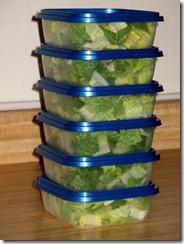
I separate the leaves from the head as I wash them, and then split each leaf in half lengthwise. Then I cut the stacked halves crosswise into bite-sized pieces. Jeremy, at Generation X Finance, shows his technique in great detail on his blog post, How to Prepare a Salad to Last All Week. He uses a salad spinner to drain the excess water after cutting, and adds a paper towel to the storage bowl. I keep the leaves wet and seal the cut lettuce in plastic containers. Try your own techniques to see what works best for you, considering your storage containers, your refrigerator temperature, and the shelf life of the lettuce or other greens you’re using.

On the first salad day of the week, I store six containers of salad lettuce for the week, and prepare one salad to eat now. For this week, my first salad is a Caesar salad.


Salad #1 – Caesar Salad
This is my “default” salad. When I don’t have a good selection of other salad vegetables to add (or when I just don’t feel like going to a lot of trouble), the Caesar salad is the easiest, least work-involved salad I can make. I use bottled dressing, packaged croutons, and pre-grated Parmesan cheese to keep it convenient. If I have some fresh mushrooms available, and the inclination, I’ll slice some mushrooms to add. I have a bottle that I use to shake up the dressing with a little water so that I can add enough dressing to coat everything without making the salad too heavy, and it keeps the calorie count down as well.


Salad #2 – Mandarin Orange Salad
This salad includes the benefit of a serving of fruit with your healthy greens. Canned oranges make this a choice that’s convenient and uses fruit that can be stored longer than fresh items. My salad ingredients also include glazed almond slices, chopped celery, and a blended dressing of oil, vinegar, sugar, and juice from the oranges.


Salad #3 – Thai Chix Salad
For this salad, I toasted a frozen chicken-patty substitute. Then I added chopped tomato, cucumber, sliced almonds, to the salad mix, and topped it with a spicy Thai peanut sauce.


Salad #4 – Greek Salad
This salad combines cucumber, tomato, red onion, black olives and feta cheese over the lettuce foundation. The dressing is a simple blend of oil, vinegar, and seasonings – shaken, not stirred.


Salad #5 – Strawberry Spinach Salad
Even though the original salad recipe calls for spinach only, I use my romaine lettuce base, and add leftover spinach from earlier in the week. Cucumbers, red onions, and almonds were also ingredients that I had on hand for use in other salads (are you noticing that several of my food items are used in varying combinations in other salads, so that everything gets used up and nothing goes to waste?). The dressing was a sweet and tangy poppy seed mixture. And, like the mandarin orange salad, this one features the bonus of a adding a serving of fruit to your daily diet – strawberries!


Salad #6 – Taco Salad
This salad is hearty enough that it can be the main entrée. Add a side serving of warm tortilla chips with salsa, and you’re all set. This salad can include a combination of whatever appropriate ingredients you have available. For mine, I started with a ground beef substitute, heated, and mixed with taco seasoning. Then I added avocado, tomato, black olives, and shredded cheese. When it comes to a dressing, there are a few compatible choices that can be used – sour cream, salsa, or a bottled dressing with essences of tomato, like Catalina French or Thousand Island. Taco salad is also a good way to make use of the broken tortilla chips that settle to the bottom of the bag, instead of throwing them away. Toasting them briefly in the oven will rejuvenate any chips that have a hint of staleness.


Salad #7 – Whatever Salad
This is the name that I chose to describe what is basically a tossed salad – romaine lettuce, mixed with whatever combination of ingredients or leftover vegetables remain to be used. For my Whatever Salad, I used a hard-boiled egg, avocado, carrots, green pepper, mushrooms, and croutons. The salad dressing I chose was a honey-mustard variety.







7 Salads for 7 Days
So there you have it – a plan to incorporate salads into your daily menu choices every day of the week, starting with the convenience of prepared lettuce (or other mixed greens), and adding other healthy ingredients for variety. If you make a salad for dinner, you might even want to make an extra serving that you can have the following day for lunch. Keep certain ingredients and dressings separate (depending on the types of ingredients involved and your own tolerance for sogginess), if you want to assemble your salad just before eating it. To get additional ideas and inspiration, search through cookbooks, magazines, or online recipe sites. The ones with photos are best. Now doesn’t this make you want to put together your own 7-day salad plan?
Posted in Diet, Personal Style, Routines, Time Management | Tagged: Caesar Salad, Diet, Dinner, Food, food prep, Greek Salad, Healthy Eating, lunches, Mandarin Orange Salad, Meals, menu planning, salad, Strawberry Spinach Salad, Taco Salad, Thai Chix Salad, weekly plan | 7 Comments »
Posted by denisefisher on February 24, 2009
I have decades of experience in writing up grocery lists. As an obsessive list maker, I’ve tried many formats. Two of the most labor-intensive models had great potential, but weren’t practical to maintain. One was a pre-printed list of “grocery staples”, which listed everything I might possibly purchase (by designated categories), and a check mark would be used to indicate each item I needed to buy. It was terrific as a comprehensive reminder of items I might have overlooked, but the list was two pages long and had to be printed out each time I needed to start a new list. The other was an electronic grocery list that I “typed out” on the keyboard of my Palm PDA. That ensured I always had the list with me if I was out and happened by a store where I could pick up a few items. After buying the products on my electronic list, I would move each purchased item below the “line” to indicate that I had bought it, and to make it easy to move each item back up to “active status” the next time I needed it, instead of retyping it. Close, but no cigar.
I’ve tried arranging my lists by the layout of the store (which assumes that I go to the same store every time), but the list that I’ve found that works best is low-tech and elegant in its simplicity. Here it is:
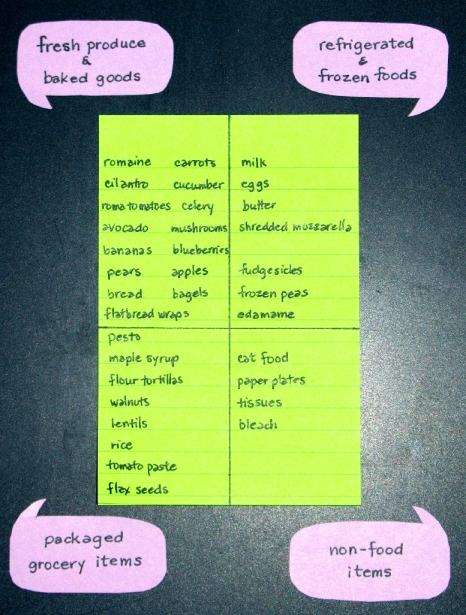
I use a 4”x 6” lined post-it note, onto which I draw a 4-quadrant grid to sub-divide the list into categories as labeled on the photo above. I stick the note onto the door of my refrigerator, where it stays until I’m ready to take it with me. As I notice food items that are consumed or running low, I add them to the list. Also, if I think of a dish that I’d like to make in the upcoming week (usually one that requires fresh ingredients that I don’t regularly have on hand), I add those needed items as well. Four general categories cover everything in the store by location, no matter which store I go to. And the limited size of the list serves as a visual reminder that if I start running out of room on the list, I may be purchasing too much.
To non-obsessive list makers, this post may seem kind of lame. That just means that this one is not for you. But for those of us who appreciate efficiency and organization, a productivity tool that is used so frequently is worth the thought and effort of a good design.
For the record, I keep what few coupons I use in a designated section of my wallet/purse so I have them with me when I need them. I don’t have very many because they tend to encourage purchases I would not usually make. Most of my food purchases are not “coupon foods”. Rarely are there coupons for produce, milk, eggs, or bread. But the good thing about it is that it keeps my shopping trips simple, it reduces coupon clutter, and it keeps me from overspending. Saving money by spending less on products you don’t need isn’t really a good deal, is it?
Posted in Diet, Finances, Organization, Personal Style, Routines | Tagged: coupons, efficiency, food purchases, format, grocery list, grocery shopping, Healthy Eating, list writing, meal planning, menu planning, Organization, Planning, post-it notes, Productivity, Purse, simplicity, Spending | Leave a Comment »
Posted by denisefisher on February 20, 2009
I know the title of this entry sounds counterintuitive, but hear me out before you discard this as a valid suggestion. Also, I’m aware that there are purists out there who rebuke the whole notion of TV-watching and label it as a productivity killer, and I can appreciate their sentiments, but I’m not one of them. Like many other luxuries and things that can be bad for you in excess, I prefer, instead, to consume TV programming mindfully, on purpose, in moderation, and to savor the experience. Now, on to the techniques.
but I’m not one of them. Like many other luxuries and things that can be bad for you in excess, I prefer, instead, to consume TV programming mindfully, on purpose, in moderation, and to savor the experience. Now, on to the techniques.
Watch TV when it’s broadcast
VCRs, DVRs, TiVo, and on-demand programming make it convenient to watch TV on your schedule, at your leisure. And that’s ok when you want to be leisurely. But to get the productivity benefit, you need to get your chores done, or your errands run, or whatever project you’re working on completed, before your show comes on. Don’t underestimate the power of a deadline (even a TV show deadline). If I see that I have less than an hour before a show comes on that I want to watch, I can go to the store, get just what I need, and make it back home in time for the opening theme song. It’s amazing. It also causes me to be more efficient in my shopping and to just get what I came for. I don’t have time to browse or stroll the aisles, checking out new products or enticing bakery selections – I have to get the rest of my shopping done so I can get out of there and get home to watch my program!
Plan your TV viewing schedule for the week
If you review the TV listings in advance, you’ll be able to select the shows you want to watch, catch the PBS special about the Lincoln Assassination, know if the upcoming episode of The Office is a new show or one you’ve seen before, and know what time your favorite college team is playing this weekend. Some shows are rebroadcast multiple times, which gives you some flexibility and allows you to determine if the show time is a “must be on time” event, or a “preferred, but not mandatory” deadline. Real-time programming is especially subject to this planning. Sure, you can watch the rebroadcast or the highlights of the Super Bowl or the Academy Awards, but it’s not the same as seeing it live. If you have a TV viewing schedule for the week, you can coordinate it with your other activities. You can catch the one-time programs or premieres that you want to watch. And you can use the anticipation of an upcoming show to motivate you during the day and give you something to look forward to.
Make intentional TV-watching a special event
Before cable, before VCRs, back when there were only three major networks broadcasting shows and primetime viewing was each evening at 8 pm, people used to look forward to watching their favorite shows when they aired. The whole family would gather around the one TV in the house, get settled into their designated viewing seat (or floor space), and quiet the ambient noise to focus on the show. There was no tolerance for side conversations, game play, or walking around during the show. You sat and watched the program attentively, with full engagement as a shared experience, and with consideration for others. TV watching wasn’t part of a continuous bombardment of audio-visual stimulation. It was special.
If you watch TV as a planned event, rather than as a background distraction to fill the silence and vie for your attention while just hanging out, it can be something special and worth doing for you too. Plan to enjoy the activity as something you’ve intentionally chosen to do (assuming that turning on the TV just to see what’s on isn’t a default activity to occupy your time because you don’t have anything else planned). If you want to have a snack while you watch, consciously plan it as part of the special event. Don’t just grab a whole bag of chips and some dip or order a pizza to sit on the coffee table and be mindlessly devoured while your other senses are otherwise engaged. Plan the food and the serving size that you intend to consume. Slice up an apple into wedges, or prepare a fresh fruit mini-platter. make yourself a cup of tea or hot chocolate, or even scoop out a some almond fudge ice cream into a serving-size bowl. Allow yourself a splurge, if that’s what you had planned, but do it mindfully, and in moderation. Make the entire event a planned and special activity.
Be the star
This tip works best when you are the only one watching a show in the room, but it can also be done in the presence of others with whom you feel comfortable, and with whom you have a similar passion for the show. Some shows lend themselves to audience participation, at one level or another. And part of the savoring – and the productivity – of watching TV, comes from immersing yourself in the program. For example, when I used to watch “Dancing With The Stars”, I would literally twirl, kick, and dance around the living room with the dancers on TV. When I watch “The Biggest Loser,” I sit on my exercise ball and do various maneuvers, sometimes with hand weights, or I have a “big salad” that I prepared in advance, with the intention of enjoying it while I watch the contestants in some kind of temptation challenge.
When I watch some kind of moving documentary, I sit tall and start to emulate the confidence and courage of the admirable character being featured. And when it’s over, I make notes to schedule a time for sorting through my family photographs and other mementos. I use the burst of inspiration I experience to take steps toward a dream that’s important in my life. Watching Suze Orman makes me want to check my financial accounts and get my estate planning documents in order. This doesn’t apply to every show you might watch, but by being selective about your viewing habits, you can feed yourself with mostly healthy choices that nourish your soul and inspire your better nature. Who can seriously say that after watching a few day’s worth of the Olympics that they don’t feel inspired to become more physically active or join a gym? This is a great productivity tool for you; you just need to recognize it and use it to your advantage.
Posted in Exercise, Personal Style, Routines, Time Management | Tagged: Broadcast, Getting Things Done, Healthy Eating, Momentum, Motivation, Production, Productivity, Program, Savor, Schedule, Special Event, Star, TV, weekly plan | 4 Comments »
Posted by denisefisher on February 16, 2009
When Congress and President Bush, and then President Obama, began discussing a financial stimulus package that would help create jobs and revitalize the economy, everyone started plotting to figure out how they could get a piece of the action. One cliché that continues to be used as a responsible justification for financial funding is “shovel-ready,” meaning project plans that have been prepared in detail, with forethought (without the incentive of the financial feeding frenzy), and are ready to go. That differentiates the industries and individuals that are looking for a bailout to maintain their status quo or to compensate for previous lack of foresight or their irrational decisions. It also excludes the opportunists who are scrambling to put together a plan at the last minute, to rationalize their worthiness for a slice of the pie.
So how does this relate to you? It should show you how opportunities favor those who have clear objectives, plans in place, and who are well represented and well connected. Opportunities arise in forms other than financial funding and you don’t always see them coming, which can make them seem outside of your control. You do, however, have control over defining your objectives, preparing plans that are written out, illustrated, and presentable, and fostering connections and group representation.
Here is my list of 10 shovel-ready projects that you should have ready for an unexpected stimulus opportunity:
1. A Publicity Package. This should include at least one photo of yourself and a brief professional biography that tells your story or, at least, a bit about your background and credentials. Kodak has some tips on photo composition (including photos for profiles) at their website, for those who wish to do it themselves.
The potential opportunity: You could be selected to be featured in a story, article, interview, or other media. You might be asked to speak at an event, and need the photo and bio for publicity, a printed program, or for an introduction. You might want to enter a contest or competition which features, as a prize, financial funding, consultation, or other support for your project or selected worthy cause. If there’s a submission deadline, you don’t want to waste time that you need for preparing your content on writing up a bio or having to get your photo taken. A photo and bio provide a credibility boost to an individual’s status and their associated venture.
2. Résumé and Business (or Personal) Cards. A current résumé can be a godsend in a situation that could advance your career, present an unexpected partnership, or identify a potential business opportunity. Well-crafted business cards (or even personal cards – those that are not necessarily associated with a company or job title, and just include your personal/home contact information) are worth carrying anywhere you’d go with a wallet or purse.
The potential opportunity: You might be acknowledged for your skills or expertise and sought out for a business opportunity. You might encounter a person who could advance your career, your business, or your pet project, if they knew more about you and how to reach you. Someone might also want to refer you to a prestigious person they know; so having a card on hand will assure that your contact information will be passed on and that opportunities are not missed.
3. Cocktail Party Introduction/Elevator Pitch. The “elevator pitch” is a commonly used phrase which refers to a business introduction that you might give to a potential investor or other “power player,” should you encounter them and have only the amount of time that it would take for a brief elevator ride, in which you could make your pitch. I coined the term “cocktail party introduction” to describe a similar introduction you might make to someone in a more casual setting, and without the hard-sell angle reserved for business situations. In either case, however, there is an element of scripting and practice required to make your introduction concise and thoughtfully worded, without seeming contrived. Try the exercise method prescribed by Laura Allen and Jim Convery at 15SecondPitch.com.
The potential opportunity: This one should be obvious. You are very likely to meet interesting people wherever you go, with whom you’d like to connect and, perhaps, establish a relationship; and it’s very likely to happen at a social gathering, if not a business setting, or a chance encounter.
4. Online Profiles. This includes any and all of the following, and more: your blog, the “about” section of your website, facebook, myspace, linked in, twitter, Amazon, classmates, online dating websites, and other member/social networking sites. Again, you should have a suitable photo and a thoughtfully written self-description that suits the venue. Check out the profiles of others if you need inspiration or ideas.
The potential opportunity: You never know who might be viewing your public online profiles and what might develop. Trying to beef-up a weak profile to create a favorable first impression after the fact is too late. Forget about the idea of maintaining separate identities for business and personal settings. That ain’t happenin’ any more; so make sure that your public persona represents you well.
5. The Plan. This could be your business plan (as a full-blown report, in a professional binder or in an abbreviated, custom-designed format of your own choosing). It could be a “back-of-the-napkin” type of sketch (only a bit more polished). It could be a photo portfolio, a 3D prototype, a book proposal, or an outline for a screenplay. Whatever it is, it should be something tangible that you can see and touch. (Check out Dan Roam’s The Back of The Napkin concepts and book at his website.)
The potential opportunity: When you do encounter a person or an opportunity where you have a chance to show ‘em what you’ve got, you’d better be ready and have something to show that represents the amount of thought, energy, and preparation that you’ve put into your idea. Just talking isn’t going to cut it. And waiting until you get that invitation for a follow-up meeting or appointment is not the time to start developing your idea into tangible plan or a model that you can present. Be ready for the opportunity before it presents itself.
6. Your Presentation Look. Your clothes, shoes, coat, accessories, hairstyle, briefcase, portfolio – do they look like “presentation material”?
The potential opportunity: If you only had an hour or two in which to put yourself together for a once-in-a-lifetime, face-to-face meeting or presentation, do you have the right look to make a great impression? This type of situation is not that uncommon, and you need to have your selections made in advance of your big break, if you really want to pull it off.
7. A Presentable Environment. A conference room or banquet hall is fine for official occasions, but you need to have your personal spaces up to the standards you wish to convey about your work/life style. This includes your workspace, your car, and your home.
The potential opportunity: If the prize patrol showed up at your door, would you be ready to invite them in and pose for a photo, without cringing at the condition of yourself and your home and self-consciously apologizing for their appearance? Ok, even if that opportunity seems extremely remote, there are others that aren’t so unlikely. A high-profile executive, a celebrity, someone you admire, or a potential love interest might show up at your workplace for one reason or another. You never know. A client or associate or someone you’d want to impress might ask to ride with you to a luncheon or event, or you might have the opportunity to offer them a lift. Would you be comfortable enough with your home environment to invite in a guest – even if it’s just for coffee?
8. A Packed Travel Bag. I’m talking about a carry-on type of bag that’s stocked with all the toiletries, cosmetics, accessories, and personal appliances you’d need, along with a swimsuit, underwear, socks and hosiery, and sleepwear you’d need for an extended weekend trip. You could add whatever clothing, footwear, and outerwear would be appropriate for the occasion of your travel, but having the basics packed and ready to go at a moment’s notice can make the difference between an opportunity being seized or passed over. Doug Dyment has an excellent website called OneBag.com that has an amazing array of advice for packing and travelling light. His single most valuable tip involves the proper use of a packing list.
The potential opportunity: What if a friend, family member, business associate or someone special offered to take you with them on an important business venture, weekend getaway, or even just an overnight stay? The occasion might only be available on short notice (maybe some unseasonable fantastic weather or an unexpected business opportunity or travel prize). Assuming you had no pressing obligations, could you go? Or would you be in the position to make a similar offer to your potential travel companion?
9. A Financial Opportunity Fund. This is a more advanced option, but important, nonetheless. It can include funding that can be used for investment opportunities, travel opportunities, a business opportunity, a special event or a fantastic deal on some item you were already planning to purchase (albeit at a later date).
The potential opportunity: Do you have money set aside (without raiding your retirement or emergency fund) to take advantage of a great deal or other opportunity that you’d readily jump on if the money was available? If you have to choose between passing up an opportunity that requires immediate funding or taking on excessive debt and interest charges, you’re not fully ready for the opportunities that will come your way.
10. A Financial Wish List. This is the counterpart to the aforementioned opportunity fund. This would include all the items and experiences you would identify for future purchase and savings goals. The list might include these types of material objects or experiences: car, furniture, electronics, appliances, flooring, fixtures, home remodeling, travel, wardrobe, books, seminar, workshop, professional classes, fitness-related activities, sports or dance equipment/attire rental or purchase, coaching, training, instruction, trip or excursion.
The potential opportunity: What if you received a cash windfall to spend in whatever way you choose? Would you use it wisely to purchase things you’ve always wanted? Do you actually have a written wish list that includes pictures, features, descriptions and prices? Someone might want to give you a generous gift or a deserving reward for something you’ve done. A wish list would sure come in handy for such an occasion. It’s also handy as an initiative for savings too. But that’s a larger topic for another day.
Posted in Finances, Organization, Personal Style, Time Management | Tagged: 15 second pitch, back of the napkin, business card, cocktail party introduction, elevator pitch, financial wish list, Kodak, one bag, photo, plan, profile, publicity, resume, shovel-ready, travel bag, your look | 3 Comments »
Posted by denisefisher on February 12, 2009
 Some days are better than others. Despite our best intentions to be productive, to be organized, to be mindful, some days just don’t turn out that way. We lack the will, the focus, or the motivation to get things done. Some days, it’s hard to even get started. What if you just don’t feel like it? After spinning our wheels and seeming to get nowhere, the day can start to seem like a total loss.
Some days are better than others. Despite our best intentions to be productive, to be organized, to be mindful, some days just don’t turn out that way. We lack the will, the focus, or the motivation to get things done. Some days, it’s hard to even get started. What if you just don’t feel like it? After spinning our wheels and seeming to get nowhere, the day can start to seem like a total loss.
But wait. There’s hope.
If you had a list of Things To Do When You Don’t Know What To Do, you’d have options. It’s hard to come up with ideas – even simple ones – when you’re feeling overwhelmed or uninspired. On a better day, you can put together a list of your own. In the meantime, I’ll lend you some of mine. They’re simple tasks you can choose to do as an alternative when your best laid plans have gone awry. It’s a menu of “Plan B” options to salvage a day gone wrong. Even if you don’t regain your full momentum, at least you’ll get something done.
- Make the bed
- Wash a load of clothes
- Run the sweeper
- Water the plants
- Put away folded clothes
- Put away dishes
- Wash the sheets to hang out on the line to dry
- Polish shoes
- Clear off the table and set it for the next meal
- Clean the bathroom sink
- Check the mail
- Walk around the block
- Wash dishes
- Clear out & reorganize briefcase/backpack
- Sweep off the porch and steps
- Get clothes and gym bag ready for workout
- Clean the kitchen sink
- Walk around and inspect the outside of the house
- Pick up leaves, pine cones, and sticks from the driveway or yard
- Empty out the refrigerator crispers and reline with paper towels
- Clean out and organize the rest of the refrigerator or freezer or just a part of it
- Dust TV screens and computer monitors
- Clear off a flat surface – pick any one or more: desk top, entry table, night stand, dresser top, dining room table, kitchen counters, work table, bookshelf
- Straighten up and clean up the cat station and organize cat supplies
- Wipe out the inside of the microwave oven
- Empty the smaller wastebaskets around the house into the larger trash bag
- Find some junk mail, papers, magazines, expired paperwork to recycle
- Take out the trash or recycling
- Check your financial accounts
- Enter financial data for accounting into software program
- Inspect the condition of the car’s exterior (maybe check the tire pressure, oil & other fluids)
- See if there’s anything that needs to be cleared out of the car or trunk
- Vacuum out the car and wipe down surfaces
- Look through some storage space to see what you have and what might need to be done
- Chop vegetables, prepare lettuce for salad, or other food preparations
- Cook or bake something that will last for several days’ meals
- Check inventory levels and restock or add to shopping list, as needed (napkins, paper towels, TP, baggies, foils, wraps, trash bags, vacuum cleaner bags & belt, tissues, liquid soap, dishwashing detergent, laundry soap, stain treatment, bleach, household cleaners, refill water bottles, water pitcher, personal products, coin compartment in purse or car, checkbook, printer paper & cartridges, travel size cosmetic containers [shampoo, lotion, Q-tips, toothpaste, sunscreen, etc.], contact lenses & saline solution, light bulbs, batteries, birdfeeder, first aid kit, medications, vitamins)
- Take a power nap
- Do some type of personal grooming (tend to your nails, ears, feet, facial or body hair, hair color/length/style)
- Call your mother (or other deserving call recipient)
- Run an errand
- Go to the library
- Review your goals/personal mission statement/mantra
- Review your to do list
- Write and e-mail reply or a letter you’ve been putting off
- Clean one or more ceiling fans
- Clean the windows on the front door (and the finger prints around the door frame)
- Plan the details of a call you’ll make tomorrow – get the name, phone number, key points, and supporting documents you’ll need to have on hand
- Gather things together that you’ll need for a project you’re going to do tomorrow – set it up so that you’re ready to start
- Listen to an educational, inspirational, or informative podcast
- Clear your inbox
- Sort through some computer files and delete what you no longer need
- Meditate in a quiet space (possibly with some suitable music)
- Read something uplifting
- Ask someone else about their day, listen with empathy, and ask how you can help them out
- Send someone a text message or e-mail – out of the blue – to tell them something you admire about them
- Go to the yoga today website and do a yoga video
- Sort/organize/group/categorize … anything (bills or receipts to file, medicine cabinet, CDs or DVD collection, utensil drawer, spice cabinet, tool box, drawers of your night stand, jewelry or other accessories, stack of firewood or kindling, art supplies, lap drawer of the desk)
- Hold your baby (your little baby, your big baby, your sweetie baby, or your pet animal baby)
- Regroup and plan to get back up to speed tomorrow
Posted in Diet, Exercise, Finances, Fitness, Health, Organization, Personal Style, Routines, Spaces & Things, Time Management | Tagged: Cleaning, Exercise, food prep, Getting Things Done, Goals, Healthy Eating, Maintenance, Momentum, Motivation, Organization, Planning, Procrastination, Productivity, Receipts, What to do, Writing, Yoga | Leave a Comment »
Posted by denisefisher on February 9, 2009
The 2009 Identity Fraud Survey Report was announced today by Javelin Strategy & Research. Their report said that identity fraud last year increased 22% from 2007. But the majority of these identity thefts were not due to online activity. Low-tech theft (or losses) of wallets, checkbooks, debit or credit cards were the most frequent sources of stolen identity and related fraud.
But this writing isn’t about about eliminating crime. It’s about personal organization and financial management. It’s about knowing what’s in your wallet. Purses, messenger bags, backpacks, briefcases or other carrying cases which hold your identification, money, financial cards and other valuables are even more critical, because they can hold even more of your treasured stuff. And if you carry them every day, you start to accumulate even more stuff and you don’t even remember what you’re carrying.
Do you know how much money you have in your wallet at this very moment? If your wallet were stolen (or if it fell over the side of your yacht) and you had to replace its contents, would you be able to recall everything inside? This may seem like a trivial topic in the overall scheme of financial management, unless you find yourself in the situation of having to deal with a lost or stolen wallet or purse and its contents.
Another reason to consider what’s in your wallet, however, is the simple issue of awareness. The same way in which you must be aware of each handful of snacks you consume, when you want to reform your eating habits, you must also become conscious of your daily financial transactions if you want to transform your financial habits. And, of course, the efficient handling of all those receipts, bank slips, and other cards and papers that fill your wallet has an effect on your financial management as well as your overall organization. Each aspect of your finances and personal organization that is in order contributes to the larger image of how “together” your life is.
When you’re starting out on a financial organization journey that may seem overwhelming, it helps to start out with smaller, manageable tasks that are easily doable and quickly completed. So here’s my 10-step plan to organize your wallet or purse and its contents.
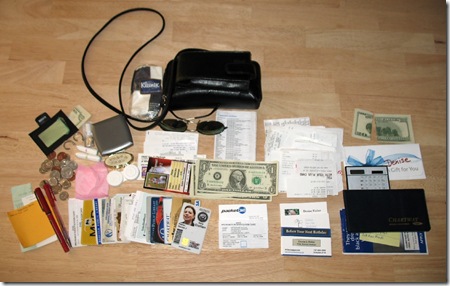
1. Empty out everything from every compartment. (As a documentary type of option – or if you’re preparing a blog post – spread out the contents onto a table or floor surface and photograph the entire collection from overhead.)
2. Brush out lint, fuzz, and debris from interior sections of your wallet or purse (use an old toothbrush, Q-tip, vacuum cleaner attachment or whatever) then use a damp cloth or paper towel to wipe off surfaces.
3. Purge the contents of trash, expired cards and coupons, and set aside receipts and other items you don’t need to carry with you in your wallet or purse.
4. Gather together all the cards you carry (driver’s license, work ID, membership cards, bank ATM cards, credit & debit cards, grocery, restaurant, and retail merchant gift, discount, or bonus point cards, medical/health insurance cards, auto insurance cards, library cards, etc.), lay them out on a color copier and make a photocopy. Then turn them over and copy the backs. Make sure you can read the account numbers, and the phone numbers to call in case the card is lost or stolen. If you can’t get a legible copy of the fine print, hand write the info in the margin of the print-out, where you can read it. File this copy with your other important documents. You may even want to have more than one copy for filing in more than one location. Remember, you’ll need to be able to find this copy if you need it.
5. Sort out the remaining contents into categories (cash, coins, checkbook, stamps, calculator, small notepad and pen, coupons, claim tickets, punch or scan cards, hygiene/cosmetic items, medical/health items, gum/mints, spare key, back-up cash, personal/business cards, grocery list, library receipts, receipts for purchased items that need to be returned or adjusted, etc.). Some organizers suggest removing cards, receipts, coupons, etc. that you don’t use on a regular basis, but I think it makes things very inconvenient – you have to store the items somewhere else, remember where “somewhere else” is when you need them; you have to coordinate the details of your errands and their associated cards/receipts/coupons etc. in advance, and if you just happen to be at the store where you need to have the associated items, you’re going to want to have your card, coupon, or receipt with you – right then, when and where you need it.
6. Survey the items you plan to return to your wallet or purse, noting what may be missing or needing action and replace or restock as required (a pen that works, sufficient number of checks, good mix of coins, meds, etc.).
7. List anything you need to do or buy, based on your wallet survey (e.g., go to the post office for stamps, buy a pill box, pick up dry cleaning, renew your library card, etc.). And while you’re at it, check out the condition and suitability of the purse or wallet you’re using to see if it’s functional for you and your lifestyle. If your wallet or purse has a smooth leather surface, you may even want to polish it, like you would a nice pair of shoes. You can figure out if your purse or wallet can use or needs a cleaning or treatment product (or some other minor repair). This is just a reminder for you to consider it.
8. After assessing the contents and available compartments, mentally designate what goes where. Anticipate the receipts, coupons, business cards, and other papers that will again start to accumulate, and assign an appropriate place/compartment for them.
9. Put the contents into their designated places and savor the accomplishment of having reorganized your purse or wallet. (This would be the point where you would take that “after” photo.)
10. This final step is an important one that mustn’t be omitted – put away any of the receipts, cards, etc., that are not trash but are not going back into your wallet either. Items with a designated home are more easily dealt with. But if you don’t have a designated destination for these items, take a few minutes to create one that you will use “from now on.” But make them easy to find and easy to use or they won’t be functional and it will defeat the purpose.
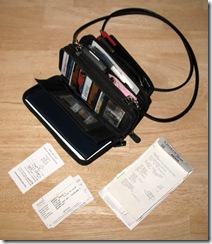
I did this process myself, in order to document the actual steps and determine how long it would take. It took me much longer to write this post than to clean out and organize my purse. I started at 1:10 pm and finished at 1:50 pm. 40 minutes total, including the photocopying and photographs.
The photo to the left shows my reorganized purse, along with a stack of receipts and some expired insurance cards that need to be filed elsewhere.
Posted in Finances, Organization, Spaces & Things | Tagged: Credit Cards, ID Card, Identity Theft, Organization, Purse, Receipts, Wallet | 5 Comments »
Posted by denisefisher on February 7, 2009

This is my plan for eating fruit for a week, in words and photos.
Take inventory
Before you go out and purchase your fruit (and presumably, other groceries), check your pantry, freezer, refrigerator (don’t forget the crisper drawers), and anywhere else you store fruit. A pre-shopping refrigerator purge is always a good idea, since it will remind you of what you already have on hand, and those cleaned off shelves and compartments will be appreciated when you return from your grocery trip with bags of food that needs to be put away.
Eat enough – but don’t buy too much
Determine the appropriate number of servings of fruit to have per day. I choose 3. Then do the math to determine how much fruit you’ll need for the week for your household – I’m only one, unless I’m planning for guests, so, 3 fruit servings a day x 7 days a week = 21 pieces or servings of fruit to buy for the week. Viewing fruit purchases in terms of the number of servings allows me to buy enough variety without buying more than I need, and then feeling guilty about wasting money and not consuming healthful fruit before it goes bad.
 This selection of fruit shows what I purchased for a week’s worth of fruit eating, except for the oranges (which were left over from a bag I purchased the week before).
This selection of fruit shows what I purchased for a week’s worth of fruit eating, except for the oranges (which were left over from a bag I purchased the week before).
Savor the variety, but don’t go crazy
Purchase a variety of fruit based on personal preferences, availability, price, nutritional variety, and number of portions. I prefer to buy mostly fresh fruit, and supplement my choices with the occasional canned, dried, or frozen fruits – which are especially suited for use in recipes, such as canned mandarin oranges or raisins that I may use in a salad, or canned pineapple chunks for a rare pineapple upside-down cake). I used to keep significant quantities of extra items on hand (you know, just in case), but recently, I’ve reformed my philosophy to keep my stock of extras to a bare minimum. I’ve realized that my money can be put to better use than sitting on my pantry shelves or in the refrigerator/freezer for weeks or months at a time, waiting for me to decide how I might use it. My revised strategy makes for roomier food storage spaces too.
Select your default serving times
Schedule routine fruit-eating times during the day. These seem to work best when they’re planned to coincide with those times when you’re a little bit hungry for something to munch on, but not past the point when you’re intensely craving something chocolate or salty-crunchy. I choose mid-morning, late afternoon, early evening – I don’t designate my times more specifically than that, although, when I used to work in an office, I used to hold out for a fruit break at 10 am. Eating fruit an hour or two before your next meal will help moderate your appetite and keep you from eating too much because you’re “starving to death”.
![MPj04308290000[1] MPj04308290000[1]](https://denisefisher.files.wordpress.com/2009/02/mpj043082900001-thumb.jpg?w=244&h=164)
Plan for the week to avoid waste
Plan daily menus or a sequence for eating the fresh fruit that you’ve purchased, based partly on how ripe or perishable each fruit is. Obviously, soft fruit and cut/prepared fruit have the shortest palatable life, though some fruit can be trimmed, blended, or cooked into other recipes, even if they’re past their apparent life expectancy in fresh form – think… banana bread, strawberry shakes, apple crisp… that kind of thing.
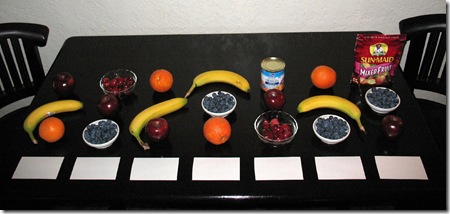 This display shows how I divided my fruit purchases (shown in the previous photo above) into 7 days of 3 fruit servings per day. The only items added to the assortment (from what I already had in the pantry) was a package of dried mixed fruit and a can of mandarin oranges that I will use in a salad. The only fruit left from my purchase was 8 apples – I could carry them over for next week, or I might want to use them for cooking or baking.
This display shows how I divided my fruit purchases (shown in the previous photo above) into 7 days of 3 fruit servings per day. The only items added to the assortment (from what I already had in the pantry) was a package of dried mixed fruit and a can of mandarin oranges that I will use in a salad. The only fruit left from my purchase was 8 apples – I could carry them over for next week, or I might want to use them for cooking or baking.
Prepare portions & packaging
Wash fruit and portion it out into serving sizes, as appropriate, especially for packing lunches or making fruit ready to eat. Cut grape stems to make serving-size clusters, put blueberries or cherries into sealable baggies or plastic containers that you can pack or take on the go. You can also cut melon into wedges, cubes, or balls, and cut stems from strawberries, etc., but only if you know those fruits will be eaten fairly quickly thereafter, or if you know they will sit and rot if they’re not in a ready-to-eat form.


Presentation is everything
Serve fruit with visual appeal and vary the way you cut or serve it, (along with how you use dips, accompanying flavors, side dishes, or recipe combinations) to make them appetizing and enticing – for example, oranges, which can be serve peeled and segmented, cut into wedges, cross-cut into slices, or served from a can, over a salad, and topped with almond chips and a ginger-sesame dressing.

You won’t eat it if you don’t see it
Make fruit viewable as a snack option – have a bowl of mixed melon cubes with strawberries on the top shelf in the refrigerator, instead of hidden, unprepared, in the crisper; set your bananas, and maybe a couple of apples, in a wicker bowl on the table; put a small dish of freshly cut apple wedges on the table next to you when you get ready to watch TV or play a board game.


Keep it simple
Most of the fruit I eat is raw and unadorned. There are several reasons for this. Of primary importance is the appreciation of its natural form, texture, and flavors. As a parent and aunt, I am aware of children’s innate attraction to fresh fruit and their delight in eating fresh fruit that is served to them. They don’t need caramel dip, chocolate sauce, or whipped cream to make it palatable, and neither should adults. In fresh form, it’s most nutritious and ready to eat. I seldom buy extra quantities of fruit with the intention of using it to make desserts – most recipes call for significant quantities of sugar and fats that add extra calories that I don’t need, so I try to treat fruit-based desserts a special splurge to supplement my fresh fruit servings, rather than replace them. The major exception to this standard is when local strawberries are in season, and I go out to pick them, or when friends or family share their abundance of ripe apples from trees in their yards. It can be tempting to purchase vast quantities of fruit with intentions of making gourmet dessert creations, but unlike boxes of purchased art supplies that sit around for years, unused, waiting to be turned into inspired creations, fruit will expire if not used promptly.
 The dessert option
The dessert option
Eat fruit in sweetened desserts, if desired, but do so in moderation (berry-banana ice cream smoothie, cherry pie, strawberry shortcake, apple cobbler). If you want to, make it a routine or policy, and give it a name, so that you can look forward to it, without mindlessly eating more desserts than you realize. Try something like Sunday Fruit Smoothie Night and Fruit Bakery Treat Thursdays. This works especially well in a family with children. They will like referring to the named days and looking forward to them, and you won’t have to say “no” to numerous requests for treats before the designated days. You can just say, “Yeah, you’re right, we haven’t had banana splits in a while. That would be good to have on Ice Cream Sunday.”
 Make tracking fun
Make tracking fun
If you need additional motivation and accountability, create a way to track your fruit-eating habits. Make a chart that you can color in, cross off, post stars, or place magnets. This can be even more effective when others in your family or workplace are tracking their fruit-eating goals. I’m sure there are online methods for doing this as well, but I’d opt for the tangible methods that give you that manipulative, three-dimensional gratification.
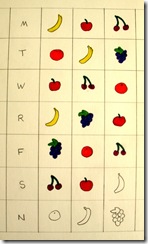
Posted in Diet, Finances, Personal Style, Routines | Tagged: eating times, food prep, food tracking chart, fruit, Healthy Eating, lunches, menu planning, weekly plan | 2 Comments »
Posted by denisefisher on February 2, 2009
 It can be tough to shift gears, settle your mind, and sustain the focus needed for a writing project of any kind. This applies to more people than just journalists, authors, blog writers, and students. If you want to create a plan for your business, career, or personal goals, you’ll need to put something in writing. If you want to document family history or maintain a journal of your life story, you’ll need to quiet your mind and devote a chunk of uninterrupted time to this task. And you can’t just do it once. It takes repeated writing sessions to articulate ideas and bring a story to completion.
It can be tough to shift gears, settle your mind, and sustain the focus needed for a writing project of any kind. This applies to more people than just journalists, authors, blog writers, and students. If you want to create a plan for your business, career, or personal goals, you’ll need to put something in writing. If you want to document family history or maintain a journal of your life story, you’ll need to quiet your mind and devote a chunk of uninterrupted time to this task. And you can’t just do it once. It takes repeated writing sessions to articulate ideas and bring a story to completion.
So many things around us stimulate the mind to race from one activity or attention-grabbing distraction to another. And the quiet, focused mindset that’s needed to write doesn’t come easily.
Enter the pre-writing exercise of listening to an episode of This American Life (TAL). This program is available through multiple media sources:
1. Your local public radio station (broadcast dates and time vary, so you’ll have to consult local programming guides)
2. Free downloaded podcasts (through iTunes or the TAL website)
3. Streaming audio you can listen to online while you’re connected to the internet
4. Purchased podcasts from the archives collection on the website
5. CDs of selected stories, available for purchase from the website’s store
While you listen to the show, through whatever means, you will find your mind calming and relaxing to the soothing voice of Ira Glass. Do not dilute this experience by trying to multi-task with other quick-paced activities. Something rhythmic, like knitting or shoe-polishing, would be ok, but stay away from large-muscle movements for these purposes.
You will find yourself engrossed in the stories you are listening to, yet, at the same time, your mind will start to engage in its own creative process. A similar thing happens when an amateur painter watches an admired artist at work on a canvas, or a casual musician sees a great performance with an instrument he plays himself. At some point, the observer experiences a compelling urge to become a creator, performer, or story teller.
You might not be able to restrain your urge to write until the end of the program, so have your writing tablet and implements, or your keyboard, within reach, even if it’s just to make notes. Then ride that wave of momentum and write for as long as you are able. You will feel such a sense of satisfaction with what you’ve done, and you’ll have a new option available to use when you’re struck with writer’s block or just a hectic lifestyle of distractions.
Here are some episodes that you may want to start with for this tip (I’ve included several suggestions, since you’ll need them for your many writing sessions):
#14 Accidental Documentaries
#314 It’s Never Over
#261 The Sanctity of Marriage
#167 Memo to the People of the Future
#174 Birthdays, Anniversaries, and Milestones
#114 Last Words
Posted in Public Radio, Routines, Time Management | Tagged: Blog, Journal, Motivation, Podcast, Public Radio, Story, This American Life, Time, Writing | Leave a Comment »
Posted by denisefisher on February 1, 2009
 Because the radio program, This American Life (TAL, for short), runs about 60 minutes (or slightly less), it’s a great way to keep track of time without having to watch the clock. You can start listening to an episode while you do whatever you need to do, and know that Ira Glass will give you timely prompts as he tells you what act in the sequence is coming up next. Pace yourself, and finish in about an hour.
Because the radio program, This American Life (TAL, for short), runs about 60 minutes (or slightly less), it’s a great way to keep track of time without having to watch the clock. You can start listening to an episode while you do whatever you need to do, and know that Ira Glass will give you timely prompts as he tells you what act in the sequence is coming up next. Pace yourself, and finish in about an hour.
Find the Time
If you search through the website, you can find many episodes with summaries that tell you how long each segment in the program lasts. Listen to the streaming podcast that corresponds with the number of tasks in your project and you’ll be able to move in rhythm to the show. If you’re undertaking a project that can be sub-divided into three or four steps, and you have selected a program with three or four acts, you will get an audible reminder when it’s time to move on to your next step.
One Major Task
If you have a single substantial task that you need to do, you can find an episode with a longer story in the middle. For example, listen to the episode titled, Welcome to America. There are three acts of various lengths – 5 minutes, then 31 minutes, then 15 minutes. Which gives you
5 minutes to get started
31 minutes to work on your task
15 minutes to wrap it up and put things away
Which makes TAL the ideal task timer.
The Clock is Ticking
If you’re just doing miscellaneous things (like sorting through the mail, putting away dishes, and straightening up around the house), but you don’t want to get carried away and forget to leave on time to pick someone up or keep with your next scheduled task, you might want to look for a differently timed program, like 20 Acts in 60 Minutes. The pace of that episode will keep you aware of the passing time, and it’s eventual conclusion.
Four Equal Tasks
Another timing strategy is to select a program with a more even division of its acts. You can reorganize four drawers in your dresser or clean out four designated shelves or compartments in your refrigerator while listening to the four-act episode of Office Politics. Its stories are 12, 15, 15, and 14 minutes long. Perfect for a project that can be divided into four segments of relatively equal time allotments.
More Ways to Use the TAL Task Timer with Your Appliances:
The Dryer
Start the show when you put your load into the dryer – you’ll have enough listening time to dry your clothes, with a timed reminder to get your clothes out and fold or hang them up. No annoying timer buzzer, and no ironing or a dryer re-fluff needed.
The Washer
For those with clotheslines and a portable way of listening … start the show as you load the clothes in the washer. Somewhere between the acts that are more than halfway through the program, the wash cycle will be completed. Then take your TAL program with you to listen to while you transfer your laundry to clotheslines or drying racks. No more forgotten laundry loads abandoned in the washer.
The Oven
Whether you’re baking whole wheat bread, a batch of brownies, a pan of lasagna, or a roasted entree that’ll provide several meals for the upcoming week, TAL is the perfect accompaniment. The built-in one-hour timer of the show will prompt you to keep the process moving and incite you to finish your clean-up before the program ends. You’d better be cleaning up when the final act begins.
I’m telling you, This American Life is the ideal task timer. You’ve got to try it. I’m recommending these programs for this tip:
#124 Welcome to America (5-31-15 minute acts)
#241 20 Acts in 60 Minutes (short stories in rapid-fire succession)
#208 Office Politics (12-15-15-14 minute acts)
Posted in Organization, Public Radio, Time Management | Tagged: Motivation, Public Radio, This American Life, Time Management | 4 Comments »
Posted by denisefisher on January 30, 2009

Listening to a show on the radio (and by radio, I mean Public Radio – the kind without commercial interruptions) has countless advantages over other types of entertainment. For one thing, it allows you to do other things while listening, so you can still be physically active and productive without diminishing the experience.
One of my favorite programs to listen to (and also one of the top [free] downloaded podcasts on iTunes each week) is This American Life, with host, Ira Glass. If you haven’t heard this program before, it might help to have a brief overview of its style and format.
On This American Life, each week they choose a theme and tell several stories on that theme over the span of an hour. The stories are often told in a mixed blend of interviews, recordings, and narrations by the authors. A really cool feature that defines the storytelling style of This American Life is the way that stories are interspersed with musical interludes.
For this series of posts, I’m enumerating five ways in which you can enjoy the program, This American Life, with additional benefits you may have never considered. Each of these listed benefits will include a suggested program that you can listen to by purchasing the podcast or listening to the streaming version of the show on the program’s website.
Getting Projects Started
When you’re facing a daunting project like sorting through an accumulation of mail and other papers, getting started on a painting project, reorganizing a storage space, or any other task that’s hard to get started, you can always count on This American Life to overcome your procrastination and make the chore more pleasant.
Before you set up your audio entertainment, gather everything you’ll need for the task. You don’t want to have to leave the earshot range of your speakers to fetch something in another room and risk missing a critical part of the story.
Make sure you have an uninterrupted hour in which to do your task, so that you will be able to listen to the entire program. Try to arrange it so that others will not disrupt you during your task, and consider turning off your phone (or at least allowing voice mail to take all but the most urgent of calls you can identify). If, perchance, you have longer than an hour to work on a project, you can always listen to an additional program of This American Life. The pause between the shows will give you a chance to make a pit stop or handle minor issues that require you to leave the area or divert your listening.
If you have not tried this technique before, you may be surprised at how easily you can get into a task that you might otherwise find grueling. Time will pass quickly, and you will be amazed at what you can accomplish while being entertained by Ira Glass and associates.
My program recommendations for this tip #1 would be either one (or both) of these two popular shows, both of which are based on real-life experiences:
#109 Notes on Camp
#352 The Ghost of Bobby Dunbar
Posted in Organization, Public Radio, Time Management | Tagged: Getting Things Done, Motivation, Procrastination, Public Radio, This American Life, Time Management | Leave a Comment »




 Last August, Seth Godin wrote a
Last August, Seth Godin wrote a 

























































![MPj04308290000[1] MPj04308290000[1]](https://denisefisher.files.wordpress.com/2009/02/mpj043082900001-thumb.jpg?w=244&h=164)











